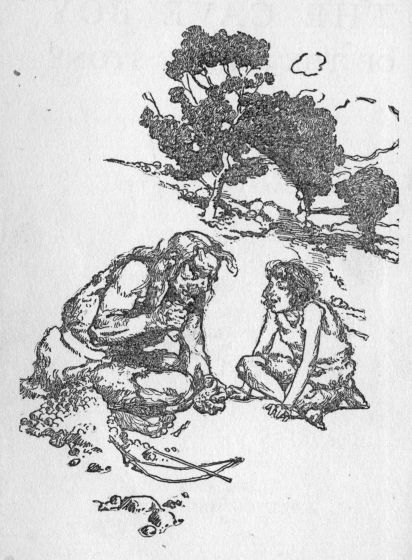
Project Gutenberg's The Cave Boy of the Age of Stone, by Margaret A. McIntyre This eBook is for the use of anyone anywhere at no cost and with almost no restrictions whatsoever. You may copy it, give it away or re-use it under the terms of the Project Gutenberg License included with this eBook or online at www.gutenberg.org Title: The Cave Boy of the Age of Stone Author: Margaret A. McIntyre Release Date: June 13, 2006 [EBook #18576] Language: English Character set encoding: ISO-8859-1 *** START OF THIS PROJECT GUTENBERG EBOOK THE CAVE BOY OF THE AGE OF STONE *** Produced by Al Haines

It was spring, thousands of years ago. Little boys snatched the April violets, and with them painted purple stripes upon their arms and faces. Then they played that enemies came.
"Be afraid!" shouted one, frowning; and he stamped his foot and shook his fist at the play enemies.
"I am fine!" called the other; and he held his head high, and took big steps, and looked this way and that.
The little brothers were named Thorn and Pineknot. Their baby sister had no name. The children looked rough and wild and strong and glad. The sun had made them brown, the wind had tangled their hair. Their clothes were only bits of fox skin. Their home was the safe rock cave in the side of the hill.
Near the children a little goat was eating the sweet new grass. She was tied with a string made of skin. Thorn stroked her and, laughing, said,
"Let us put the baby on the goat's back and see her run."
"Oh, that would be fun!" cried Pineknot, and he ran and untied the goat.
Laughing, Thorn put the baby on the goat's back. The little fingers clung to the goat's hair.
Then Thorn struck the goat and shouted, "Run!"
The goat ran; the baby laughed; Pineknot danced and clapped his hands. All at once, the goat stood up on her hind legs. The baby fell off, and rolled over and over on the ground. She cried out, though she was not hurt. And the boys laughed and shouted till the woods rang.
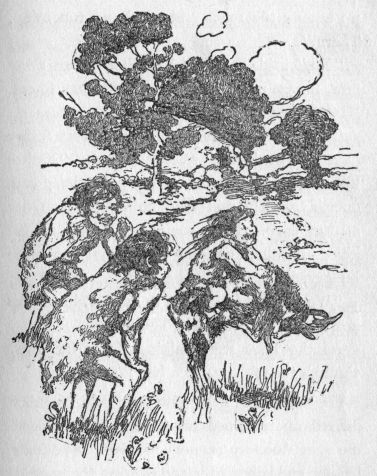
After a while Pineknot thought of the goat; he had not tied her.
"Where is the little goat? Oh, there she is up among the rocks. She did not run away, Thorn."
"No," said Thorn, "she will not run away now, for we pet her and give her things to eat. Mother feeds her, too."
"Oh, but she was a wild one when father brought her home," said Pineknot. "Father killed the mother goat and caught the young one alive. He said that he would keep her at the cave. Then some day when he had killed nothing on the hunt, and we were hungry, he would kill the goat."
"We will ask father not to kill her, but let us keep her for a pet," said Thorn.
As the boys were talking, from far away through the forest came a big, merry song:
"The wild horse ran very fast,
But I ran faster!
The wild horse ran very fast,
But I ran faster!"
"It is father coming from the hunt," said Thorn, jumping to his feet.
"He is bringing wild horse meat. Good, good!" cried Pineknot.
Thorn threw the baby on his back, and together the boys ran into the forest to meet their father.
The forest—oh, it was beautiful! The trunks of the old trees were big and rough and mossy. And there were tall ferns and gray rocks and little brooks, and there was a sweet smell of rotting leaves.
"The wild horse ran very fast,
But I ran faster!"
still sang the young hunter, shaking his red hair gaily. He was not tall, but his legs were big, for he ran after the wild horse and deer and ox. And his arms were big, because he threw a great spear and a stone ax. His name was Strongarm.
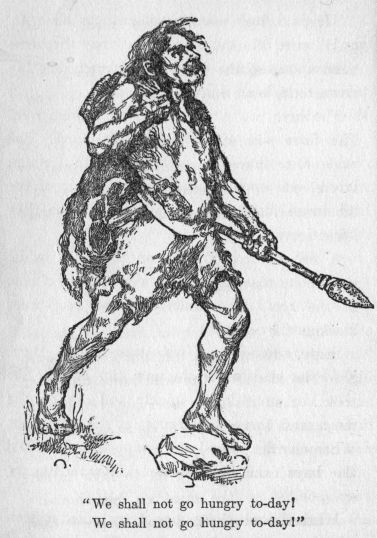
The boys came running up to their father. They pointed to the meat on his shoulder, and laughed and shouted and clapped their hands.
"We shall not go hungry to-day!
We shall not go hungry to-day!"
they sang as they danced along.
"Ho, ho, ho!" sang Strongarm to his wife, as he went into the cave. He threw the horse meat upon the floor with a loud laugh, and lay down on a bear skin to rest.
The cave was a big room with a high roof. The floor was of dirt and very hard. The walls were limestone rock in beautiful rough layers, one upon another. From the roof the limestone hung in long pointed shapes, like icicles.
A fire burned brightly on the floor, while the smoke rose slowly and went out at a hole in the roof. The walls and the roof were blackened by smoke.
Strongarm's young wife was named Burr. She was glad when she saw the meat. She took her stone knife quickly and cut up the meat, and threw the pieces on the hot coals. While the fire blazed and snapped and cooked the meat, the boys looked on with hungry eyes.
When the meat was done, Burr pulled it from the fire with a long stick. The boys and Strongarm snatched it up and tore it to pieces with their white teeth.
"Um-m! how good and tender and juicy!" said the boys, grinning, and smacking their lips.
When the meat was all gone, the bones were broken and the sweet marrow scraped out and eaten; for that was good, too.
While the family was still eating, a big black bear came along. He smelled the meat, and put his great rough head in at the door and sniffed.
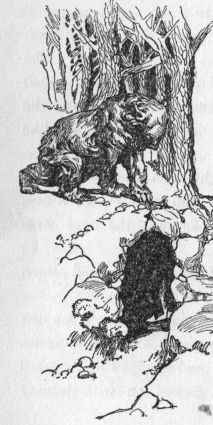
"Bear!" shouted Strongarm, jumping to his feet.
Burr and the boys cried out and quickly ran away to hide. Strongarm snatched a blazing log and struck the bear. He was burned and hurt, and he grew angry. He stood up on his hind legs and growled and showed his sharp teeth.
Strongarm snatched his ax and made for the bear, but he had gone. His growls sounded farther and farther away. Still Strongarm stood with his ax ready, his heart thumping and his eyes big. When he saw that the bear was not coming back, he dropped his ax with a gruff laugh. Then Burr and the boys came creeping out of their holes. And they all laughed and talked at once, telling how scared they had been.
The growls of the bear still sounded through the woods, so the boys ran to the door to see him.
"There he goes!" cried Pineknot with wide eyes, pointing.
"How big he is!" cried Thorn; "I shall make his picture."
Thorn ran back into the cave and quickly threw a pineknot on the fire. It blazed up and made all the cave light. He broke a piece of limestone from the wall and picked up a sharp stone from the floor. Then he sat down by the fire to make his picture of the bear. After a while he held up the piece of limestone with the picture scratched on it.
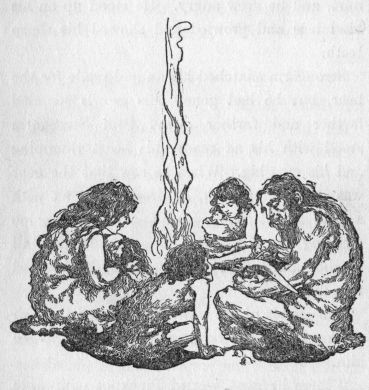
"O mother," said Pineknot, laughing hard, "see Thorn's picture of the bear. It shows his big body and his long head and his little ears."
"That is the very bear that made us run," said Burr, laughing.
All this time Strongarm had been making a picture of wild horses. He now held up the picture, scratched on a piece of deer antler.
"See, this horse has his ears up," he said. "He heard me coming. Here I am with my spear."
Burr and the boys crowded round and said, "Oh!"
While Strongarm and the boys were making pictures, the baby had been tumbling about on the floor. She crept around or pulled herself to her feet by holding to the rough places in the wall. After a while she grew sleepy; then her mother took her in her arms and sang this song:
"Little child!
Little sweet one!
Little girl!
Though a baby,
Soon a-hunting after berries
Will be going.
Little girl!
Little sweet one!
Little child!"
The baby went to sleep, and Burr laid her on a bear skin on the floor. Soon afterwards Pineknot fell asleep on another skin, and in a little while Thorn lay beside him. Then Burr put ashes over the coals, while Strongarm threw burning logs before the door. Soon all was quiet in the cave. The cave folks had gone to sleep.
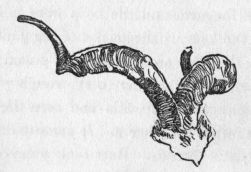
Nearly every day Strongarm went out to hunt. But he did not always bring back meat to the cave, for he could not always kill an animal. But sometimes he brought home the meat of deer or bison, and then again it was that of mammoth or ox.
Burr always took the meat when Strongarm brought it home, and sometimes she cut tendons from it. A tendon is a strong white cord that fastens a muscle to a bone. There are long tendons in the backs of big animals. Burr cut these out sometimes and hung them in the sun to dry. When they were dry, she broke the thin outside skin and tore the tendon apart with her fingers. It came to pieces in many little threads. Burr took some of the little threads and twisted them together and made a good strong thread for sewing.
One day she sat before the door of her cave sewing together skins of wild oxen.
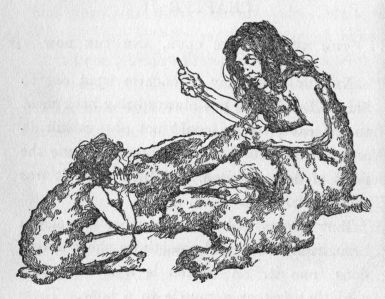
"What is the big skin for, mother?" asked Pineknot, who ran up.
"To lay on sticks above our door," said Burr. "Then, even when it rains, we can sit outside."
"Oh, that will be fine!" said the boy.
Burr went on with her sewing. She made holes along the edge of the skins with a sharp stone. Then she threaded her needle. She put it through a hole in each of the skins and pulled it tight. She worked on in this way and sewed the skins together.
"Where did you get the needle, mother?" Pineknot asked next, looking at it closely.
"I made it," said Burr. "When your father brings birds or deer from the hunt, I sometimes take a little bone from the leg of a deer or the wing of a bird. This I put in the cave to dry. When it is dry, I rub it smooth with sandstone. Then I must have a hole in one end to carry the thread. I take a sharp stone and turn it round and round on the little bone, pressing down. It is not hard work. In that way I make a smooth hole in my needle."


"But when my mother sewed," Burr went on, "she used a little bone to push the thread through the skins. One day she found a little bone with a hole in it and took it home. She put her thread through the hole, wondering how it would do, and began to sew. Soon there was a crowd of women round her, pointing and saying, 'Oh, oh!' while the little bone carried the thread."
"It must be fun to sew with a needle," said Pineknot.
Thorn was nearby making bone whistles and marrow scrapers, and soon Strongarm came up dragging a little tree. He threw down his old hunting club and said, "It is broken. I will make a new one."

With his stone ax he hacked off the top and roots of the tree; then he stripped the bark from the small end, and rubbed it with sandstone.
"It must be smooth or it will hurt my hand," he said to the boys who stood watching him.
"In the old days," he said, rubbing away, "the cave men had nothing to fight with but a club. Before they had even that," he went on, grinning, "they fought with nails and teeth, or with a stick or a stone snatched from the ground." Then laughing loud, he added, "No wonder that in the old days people lived in trees, and ran if they saw a wildcat."
"I should be sorry if you had nothing to hunt with but a club, father," said Pineknot, making a long face. "We should go hungry oftener than we do now."
After they had gone into the cave, the boys began to play with the baby. In fun they pushed her into the room behind the one they lived in. She cried out, because she was scared at the darkness.
"How loud her voice sounds in there," said Thorn.
"What is the rest of the cave like, father?" asked Pineknot. "Is it very big?"
"Yes, it goes far back into the hill," said Strongarm. "I have never been to the end of it, myself."
"Show it to us, father," said Thorn; and he ran to get a burning knot.
Strongarm took the torch and led the way into the next room. He held the torch up high. The light looked small and dim in the darkness of the big room. They went on and came to room after room and to long halls. Some places were narrow and low, so that they had to crawl on hands and knees to get through; and all the walls and floors were wet and slippery.
Everywhere in the cave the limestone showed beautiful rough layers. In all the rooms long pointed rocks hung from the roof or stood up from the floor. Water dripped from each pointed rock above, and fell on the pointed rock just beneath. In many places two pointed rocks touched each other and formed a great, rough, beautiful pillar. In some of the rooms the walls and pillars were lovely and white, glistening in the torch light.
The boys looked at all these things in wonder.
When at last they had come back to their own room, Pineknot asked, "Father, what is the water that we heard trickling in the cave?"
"It is a stream. It used to come down through that hole," said Strongarm, pointing to the smoke-hole. "But afterwards it went down another way."
He sat thinking for a while. Then he said, "When I fought with the other young hunters and carried off your mother, I wanted a cave to bring her to. I came to look at this one. Bears were living here then. But one evening while they were all away, I came in and made a fire at the door."
Strongarm laughed long and loud, and the rest laughed to hear him.
"Since then the cave has been mine," he went on. "Well, you should have seen the floor! It was covered with old bones that the bears had brought in to gnaw. I threw them all out and broke off the rocks that stood up from the floor. That gave more room. Then I brought your mother here."
"It has made us a good safe home," said Burr, nodding her head.
After a while Thorn jumped up and said, "I want some honey."
He took a burning stick from the fire and ran out. He walked through the forest and looked and listened. At last he saw bees go into a hole in a hollow tree.
"Here is my bee tree!" he cried, waving his torch.
Bees were in a crowd about the hole, crawling over each other, and going in and coming out. Thorn could hear them humming from where he stood. He swung his torch from his arm; then, hand over hand, up the tree he went.
When he came to the bees' nest, he threw his leg over a branch. He swung the smoking stick back and forth. The bees flew off humming angrily. Thorn quickly broke off the yellow honeycombs and put them into his bag. Then down the tree he slid, followed by the angry bees.
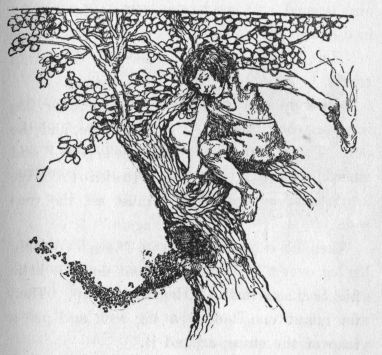
"Oh, oh, oh!" he cried, as he ran like a deer. When he went into the cave with the wild honey, the baby held out her little hands. He gave her some and said, "You are sweet. You are honey."
So the baby came to be called Honey.
At sundown, the boys went out into the woods to set the traps. A beautiful mother deer and her fawn were drinking at a brook. Crickets sang under old bark, and frogs on the edge of the pond. And birds were singing their low sweet evening songs.
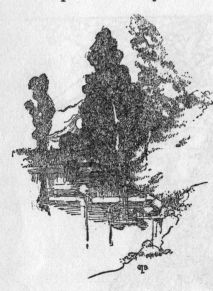
The little hunters went straight on from trap to trap. But they found no fox or wolf or wildcat in any of them. They were sorry. One trap was sprung.
"Something has been here, and the meat is gone," said Pineknot. "We must set the trap again."
Thorn quickly bent down a little hickory, and tied a string to the top. Then he raised one end of a big rock and put a loop of the string around it.
Pineknot was busy setting a trigger under the rock. All this time, Thorn stood by, playing with the string, pulling it and letting it go, pulling and letting go.
"Listen," he said, "it sings like the wind." Pineknot had a stick in his hand and, for fun, set it against the string. When Thorn let the string go, the stick was shot out of Pineknot's hand, and against his bare body. He yelled, and Thorn opened his eyes in wonder.
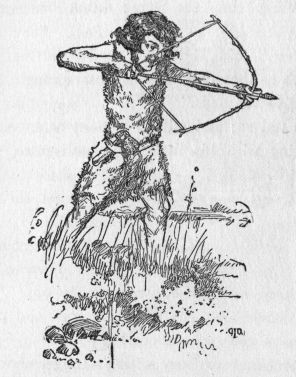
Pineknot rubbed the place, but picked up the stick, stood aside, and set it as before. Then he said, "Do that again."
Thorn did it again, and the stick flew among the trees. Over and over again they tried it, and every time the flying string threw the stick.
"Now," said Thorn, "I shall bend a little branch as that tree was bent, and I shall tie a string to the ends."
He did so; and all the way home he kept shooting with his little bow, and wondering about it.
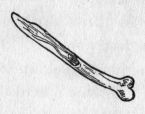

Early one morning Strongarm went out to hunt. Cattle with wild eyes were eating grass on the edge of the wood. Strongarm dropped to his knees and slowly, carefully, crawled through the bushes toward them.
"Just a little nearer, and I will throw my spear!" he thought.
A dry branch snapped beneath him! The wild cattle threw up their heads, and with a hurry of feet were soon lost to sight.
Frowning, the hunter got up from his knees and walked on. He saw a herd of mammoths, but he could not kill one of the big hairy elephants alone, so he turned away. He hunted all day long. He saw plenty of wild animals, but he could not get near enough to kill one. He saw wild ducks and grouse, but he had not brought his sling.
"Must I go hungry to-day?" he growled, frowning.
From far off came the yelping of dogs.
"The pack is hunting!" he shouted, with a roaring laugh. "I will follow the wild dogs and take some of the meat they leave!"
Led by the sounds, he found the dogs running down a bison. They followed it until it was too tired to fight, and then pulled it down and killed it. They ate all the meat they wanted and went away. Then Strongarm cut meat from the bison.
On his way home he saw a nest of wild puppies in a hollow tree.
"Um," he grunted, "the little wild goat that the children play with is quiet and tame. If a wild puppy grew up with them, would it be tame? Would it help me to hunt?"
He picked up a puppy. When he got home, he dropped the little ball of soft black wool between the two boys lying on a bear skin.
Then there were merry eyes, laughs, and soft calls:
"Here little pet!" and "Oh, the little sharp teeth!"
At last a tired little ball fell asleep in brown arms.
The puppy grew fast and was full of play. He followed the boys everywhere, and they called him "Wow wow."
One day they were playing by the high rock, when the puppy saw something in the woods and ran after it.
Pineknot called to him, "Come here, Wow wow!"
And the call came back from the rock, "Wow wow!"
"Oh, hear my talking shadow, brother," said Pineknot.
"Yes," said Thorn, laughing, "let us talk a while with our talking shadows."
So they lay down on the ground and began to call.
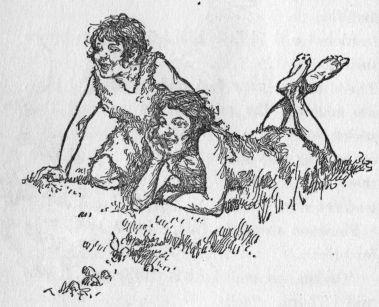
"Ho, there!" called Thorn.
"Ho, there!" came back from the rock.
"Come here, talking shadow."
"Shadow," was the answer.
"We want to see you," called the boys.
"See you," said the echo.
"Ho, ho, ho!" laughed the boys.
"Ho, ho!" laughed the talking shadow.
That evening Pineknot came running to the cave, calling, "O Thorn, I was coming along on the high rock, and I heard little cries. I crawled through the bushes and looked over and saw a nest full of young eagles. They were skinny and had no feathers on their bodies. The nest was made of sticks; and oh, it was big, and there was a lot of feathers in it!"
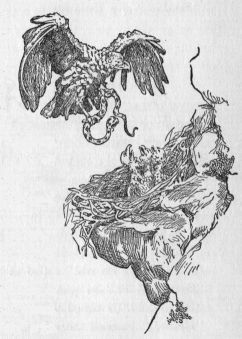
Pineknot stopped for breath.
"Go on, go on," said Thorn, "tell more."
"As I looked, a shadow bird went over the rock," said Pineknot; "and then down dropped the mother eagle with a snake in her claws."
"Oh," cried Thorn, "I wish I had seen it."
"The young eagles held their mouths open," Pineknot went on, "and their mother fed them with the snake, a little bit at a time. When the snake was all gone, the mother eagle waved her big wings and flew away. Then the young ones' heads fell down. They were asleep."
A day or two after that, Thorn came into the cave with an eagle's feather in his hand. And there were long red cuts and scratches on his body.
His father looked at him with a scowl.
"Men bring meat from the hunt, not feathers," he said roughly.
The boy looked pitiful; his mother felt sorry for him. She said to herself, "He has been to see the young eagles. The mother eagle saw him. He fought her alone with his little stone ax. He will be a great hunter!"
She looked at him proudly, and put cold water on the little torn body.
"Gr-r-r," growled Strongarm, scowling. "Would you make a baby of the boy? A fight is good for him. He will learn to make his way."
In those days Strongarm was busily digging a big hole away out in the forest. He cut the dirt up with his stone ax, and threw it out with a clam shell. He had worked now for days, and at last the hole was large enough. He laid branches over it, and over the branches he hung the leg of a wild goat.
That night the wild things of the woods came out to hunt for food. A cave bear came by and smelled the meat. He went to get it and fell through the branches into the hole beneath.
The next day when Strongarm went to the hole, he found the great cave bear in it. He killed the bear and carried the meat home to eat, and the skin to sleep on.
Burr took the bear skin from him and laid it out on the ground. She drove sticks down through the edges, all the while pulling the skin tight. Then with her stone scraper, she scraped off all the meat and fat. She left the skin stretched on the ground, and thought, "It will dry there, and another day I will scrape it again. Then it will be good and soft to sleep on."
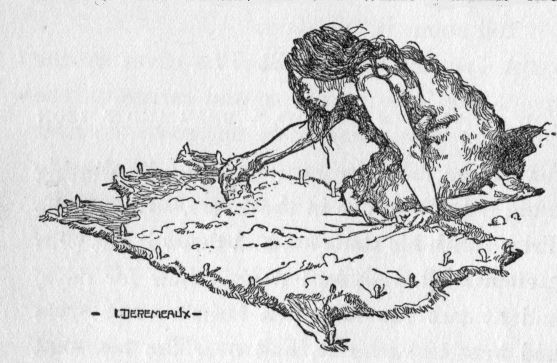
She looked up as a man came running toward the cave.
"Oho, Hickory!" called Strongarm, "what is it?"
"A lion hunt!" shouted Hickory, and shook his spear.
Strongarm's bold face lighted up.
"Tell about it," he said.
"A lion has come among the caves by the river. He kills the people and carries off the children. The women dare not go to the river for water. The men are afraid to go alone to hunt. So they want help to kill the lion. They want all the strong men and the good hunters. They have sent for you."
Strongarm quickly took his club and spear and went off with old Hickory. The men went over two hills and across a stream, and came to Hickory's cave. There other men joined them. All the men had clubs and spears and stone axes. They went together toward the river caves. They found the lion and killed it.
Strongarm came home after some days, bringing lion's meat. Burr cooked it, and Strongarm said to the boys, "Eat, it will make you brave."
After a while Strongarm sat down and made a hole in a lion's tooth. Then he took off his necklace. It was made of shells and bears' claws and a tiger's tooth and a bit of amber. He put the lion's tooth on his necklace and held it up and looked at it and said, "Men will see that and say, 'There is a brave man. There is a good hunter. He has helped to kill a lion.'"
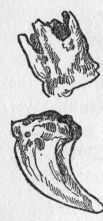
The boys stood by, watching. Thorn pointed to the tiger's tooth.
"How long and sharp it is! I never saw a tiger."
"You never want to see one unless you are where he cannot see you," roared Strongarm.
"Tell us about the lion hunt, father," begged Pineknot.
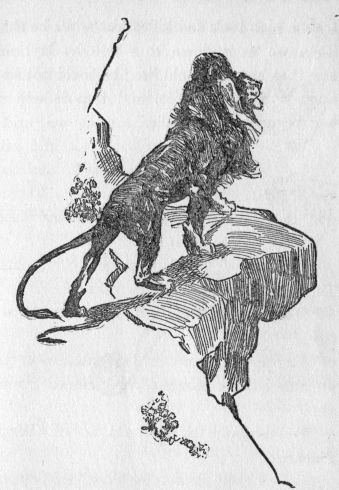
"We watched the lion for days," said Strongarm. "We found that he slept nearly all day in the thick reeds by the river. At sundown he went out to hunt. He hunted all night; we heard him roar at times. In the early light he went back to his bed of reeds by the river and went to sleep. We rolled a big stone from a high rock and killed him while he slept. Then we went down to where he lay. We saw that he was an old lion; he could not hunt animals enough to eat, and that is why he had begun to kill people."
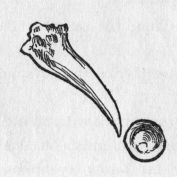
As they were talking, a long call came from far away. They listened. The call came again, and Strongarm put his hands to his mouth and answered.
"It is old Flint, the ax maker," he said to his wife.
"Grandfather!" cried the boys, and they ran to meet him.
Soon they came back with an old man. His hair was rough and gray, but his eyes were bright under his bushy eyebrows. He wore an old brown bear skin.
"Ho, man!" called Strongarm, "come on!"
"Sit and rest, father," Burr said.
The old man sat down on the root of a tree. Burr brought him bison meat and wild honey and a horn of water.
"Eat, you are tired and hungry."
The old man ate all he wanted. Then he began to talk. He told about his wife, and the work at the stone yard and the gravel bed, and of the men who had come from far away to buy his axes.
The boys stood by and listened.
After some time Burr looked at the bag on the old man's shoulder.
"Have you a new ax in there for me?" she asked with a little laugh.
Smiles came about the old man's mouth, and he slowly pulled four beautiful chipped axes from his bag. One ax was big and heavy. That was for Strongarm. He handed it to him. Another ax was small and light. That was Burr's. She put out her hand for it. There were two little axes. These the boys snatched with shouts of joy.
The axes were wide at the sharp end and narrow at the head, and you could see where every chip had come off.
Strongarm turned his ax over and looked at it. He rubbed his fingers along the rough sharp edge.
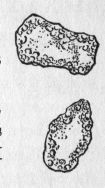
"That is a good ax," he said, and he held it up and looked it all over again.
"Grandfather," said Thorn, pressing close to the old man's side, "when I am a man, I shall be an ax maker like you."
"Begin now," said his grandfather, with a gruff laugh. "It takes a long time to learn to make a good ax."
"Can anybody learn?" asked Pineknot.
"No," said Flint. "Some men can chip stone, and others cannot. That is why some men make axes, and other men use them."
"Well, I will try," said Thorn. "When you go back to the stone yard, I will go with you."
Strongarm turned round where he sat and pulled up a little hickory tree. "We will put handles on these axes," he said.
He hacked off a piece of the little tree and split it half way down, and hacked off one split piece. The other split piece he bent around his ax. Then he took wet string made of skin. This he put around and around the ax handle, and pulled it tight.
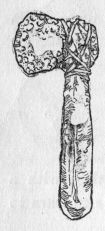
The boys stood by watching. "The wet string will shrink and draw up short," their father told them. "Then the ax will be very tight on the handle."
The boys now tied on their ax handles with their father's help. And Flint tied on Burr's. Then all set to work with sandstone pebbles and rubbed them smooth. Strongarm's was soon done. He threw his old ax away, stuck his new one in the string around his waist, and went off to hunt.
Burr took her digging stick from beside her door and hacked a point on it with her new ax. Then she burned the point in the fire until it was hard. She took a basket in her hand, and her baby on her back, and went out of the cave. Old Flint and the boys rolled a stone up to the door to keep out wolves and foxes. Then they all went into the woods, and Burr began looking for things to eat.
She found a root and pushed it out of the ground with her digging stick and threw it into her basket. It was the root of a wild turnip. She found other roots. They were wild carrots and celery. In the open places, tall grasses grew. They were the wild grains. These she bent over and beat with a stick until the ripe seeds fell into her basket. Under the oak trees she gathered acorns.
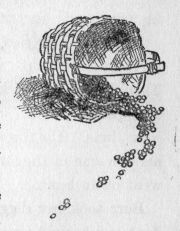
Little wild pigs were there eating the acorns, and the boys ran one down and brought it, squealing, to their mother. Burr laughed and said, "You are little men. You will soon hunt for yourselves."
It began to rain, and they all sat under a tree until the rain had passed.
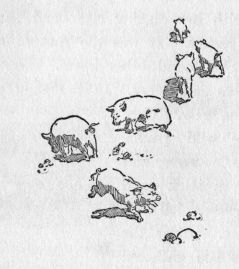
When Strongarm came back from the hunt, he found the cave cold and dark and wet. A stream of water was running down through the smoke-hole. It had put out the fire. The ashes, too, were wet; and there were no coals from which to start the fire again.
He looked at the black fire-place.
"Now I must walk all the way to old Hickory's for fire," he grumbled; "and it is growing dark."
Tired and hungry, he left the cave.
He had not gone far when a dead branch fell across his path. He jumped back.
"The people who live in the trees did that—some of those shadow people," he said to himself. "They tried to kill me. The man who lives in the wind is angry, too. Hear him roar!
"I do not like shadow people," he thought as he walked on. "They live in trees and wind and rivers and fire and stones and everything, but you cannot see them. They will hurt you if you make them angry. I am afraid of them. I wish I had a torch to scare them off. All the other shadow people are afraid of the fire man."
Then to keep up his heart he sang in a loud gruff voice:
"O why did the water put out the fire?
O why did the water put out the fire?"
Strongarm gave a loud call as he came up to Hickory's cave. The old man came to the door and asked what the trouble was.
"Trouble enough," growled Strongarm. "My fire is out. I came for coals."
Old Hickory gave a great roaring laugh. His wife laughed, too, as she pushed the children aside and raked out coals. These she put into a hollow branch that Strongarm handed her.
"They will keep alive in there," he said, "even if it rains."
Then with a good pine torch and his branch full of coals, he hurried home.
When Burr came back to the cave, she, too, found the fire out. There was a deer on the floor, so she knew that Strongarm had come from the hunt.
"The man has gone to old Hickory's for fire," she told her father.
"Um," said Flint, "he might have rested his legs. I can get fire from stones."
"From stones!" cried Burr, her face white.
The old man quietly pulled two stones from his bag. One was flint, the other was quartz. He took dry leaves from his bag and rubbed them very fine between his hands and laid them on a rock. Over the leaves he held the two stones and began to strike one with the other.
Burr and the boys watched with scared faces.
"The fire man—will he not be angry?" she asked.
Flint said nothing. He was striking the stones together. A spark came! then another and another! He kept on striking very fast until the sparks came like a flame and caught the dry leaves. He put on more leaves and little sticks, and soon there was a good fire blazing on the floor.
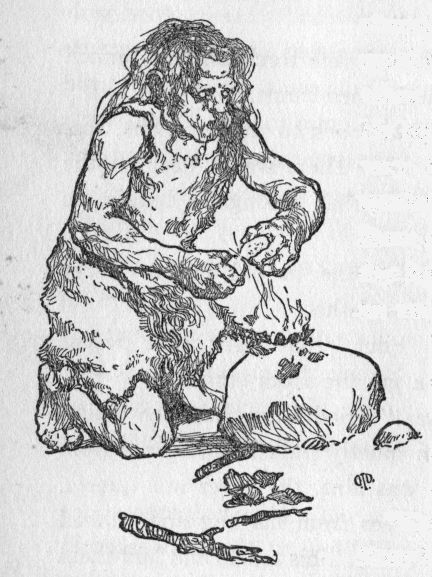
"From stones!" Burr kept thinking, as she shook her head and watched it out of the corner of her eye.
When Strongarm came with the coals, the cave was already warm and light and full of the smell of good things cooking. He looked at the fire and wondered where it had come from, but said nothing.
Near the fire his wife had a basket lined with clay. In it were the seeds of the wild grains and acorns, with hot coals. She shook the basket around and around until the seeds were roasted. Then from the ashes she pulled the roots she had put there to roast.
After Strongarm had eaten, he lay down by the fire. Nodding toward it he said, "Where did you get it?"
Flint then told him that he had brought it out of stones. Strongarm sat up and looked hard at Flint. Then Flint had to strike the stones together again, to let Strongarm see the fire come out.
"Beaver Tail, an old ax maker, showed me how to do it," said Flint. "He has worked in stone all his life. For a long time he has known that fire lives in stone. He has seen sparks fly as he chipped his axes. One day in making a spear head, he struck a quartz pebble with his flint hammer stone. A big spark came! He struck again and again, and the sparks came fast and caught the dry grass at his feet!"
"Um," grunted Strongarm, wondering. He thought for a long time; then he looked at Flint and said, "Fire lives in wood, too! My ax handles grow warm as I rub them."
The boys listened in wonder to their grandfather's strange story of the making of fire.
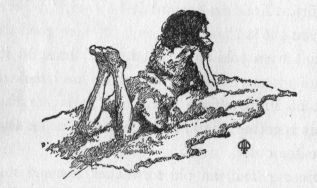
After a time Thorn said, "We have always had fire in the cave. All the cave folks have it. They did not bring it from stones. Where did they get it?"
"Once, in the old days," Strongarm said, and turned to the boy, "a man saw fire come out of the sky and begin to eat up the woods! He could feel the fire from where he stood. It made him warm, and he liked it. But he was afraid to take any, for he thought the fire man might be angry. But at last he did take some. He kept it, and grew to like it more and more. With it burning beside him, the night was not so dark, and he was not afraid; for the hungry wolf and tiger turned away—teeth and claws could not fight fire!
"The other men saw that it was good to have fire; so, in time, they took some of it. And ever since then every man has tried to keep his fire burning."
"It is better for us cave folks since fire came," Burr then said, nodding to the boys. "Why, before it came, there was no cooked meat, nor were there any sweet roasted seeds or roots. But the folks tore their meat from the animal where it was killed, and stood by and ate it raw.
"Nor was there a home before fire came. My grandmother told me that, long ago, in the old days, the men and women wandered from place to place with their little children. And the women hunted and fished and fought beside the men. And at night the people curled themselves round as the wild dogs do, and slept on the ground; and the rain wet them, and the cold winds made them shiver.
"But after fire came, all this was changed. For the fire would go out unless there was some one to keep it. So a man told his wife that she might stay and keep the fire, and said that he would hunt for both.
"The woman then took a place that she liked, near a stream, and built a shelter of branches and made her fire there and kept it. And the man brought meat to her, and she cooked it. And before very long all the people were living in that way. And so ever since that time, the man has been the hunter, and the woman has kept the fire and brought water from the stream and gathered seeds of the ripe grasses."
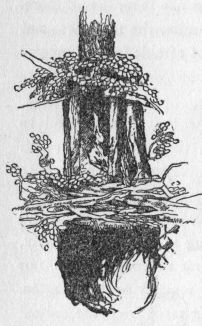
"And always since then, too, the family place has been about the fire. We sit beside it and warm ourselves and work and talk and rest; and that is home."
"True, true," grunted old Flint; and Strongarm nodded his head.
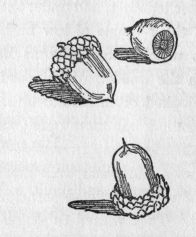
One morning not long after the lion hunt, Thorn and his grandfather started off to the stone yard. They soon came to the deep forest where they could not see far ahead of them, because the beeches and oaks and chestnuts grew close together, and under the branches there was a thick tangle of low bushes.
Old Flint watched carefully as he led the way through the woods. He listened to every sound, and looked often behind him. Farther along, the ground was more open; and from a hill they looked far away over wide level land. Herds of horses and bison were grazing there, and packs of wolves skulked through the edge of the forest. They waited to spring upon the animals that should stray from the herds.
Passing on, old Flint came upon the body of a rhinoceros partly eaten, and he stopped and looked anxiously around.
"This is the work of a tiger," he said; "and he cannot be far off, for the meat is fresh."
Flint peered through the bushes; but the tiger was not in sight, so he quickly cut meat from the rhinoceros and walked on slowly.
"The tiger may be somewhere near, sleeping. Keep a sharp look-out, boy; he is yellow with dark stripes, just the color of the dry grass, and you can walk almost onto him before you see him. No animal can hide better than he, and none can walk the forest paths with less noise from his padded feet."
They had not gone much farther when old Flint stopped and, catching his breath; stared into the shadows of a tree. Clutching Thorn's shoulder, he pointed to the spot without saying a word. There on a limb, asleep, beautiful in his tawny skin and easy grace, lay the great animal. Thorn looked while his heart beat fast. Never before had he seen anything that so held his eye. He would have liked to stay and watch him—to see him walk, to see his great claws and teeth, and his wild eyes. But Flint hurried him off, and without a sound they left the place. Not till he had put miles between himself and the tiger did Flint shake off a feeling of terror, and speak in answer to Thorn's question:
"How does the tiger get things to eat?"
"He steals to the river bank where the shade is deepest," said the old man, recalling many a sight of the crouching beast. "There, on some over-hanging limb or rock, he waits for deer or horse or any other animal to come to drink. Then from his hiding place, with an angry snarl, he springs upon the back of his prey."
"Oh, many a time I have seen him," continued old Flint, thinking of past years; "for when I was a boy, my father's cave was in a high cliff, close to the river. A little way below, there was a place where the animals came to drink. And often I have felt the hair rise on my head as I heard the cry of some wounded animal, and saw it rush away with a yellow patch clinging to its neck."
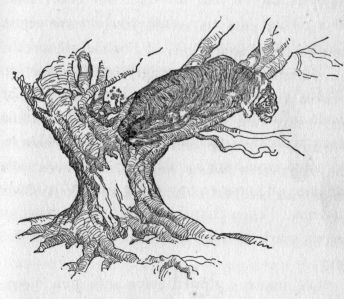
"I have a tiger's jaw which I found once long ago. You may see it some time. Then you will know why the tiger can kill the rhinoceros, whose thick skin no other animal's teeth can pierce. In the tiger's upper jaw, there are two teeth that are long and sharp and thin. The tiger thrusts these into the neck of the rhinoceros, and he sinks to the ground, and the tiger feeds upon him."
"You say the tiger springs upon the back of the rhinoceros. Well, what would happen if he should miss, and not land on the back?" asked Thorn.
"In that case he would likely have short time to live," said Flint. "For the rhinoceros is a furious beast when angry. If he gets his terrible two-horned snout under the body of his enemy and gives an upward fling of his powerful neck, the end is near. So fierce is the rhinoceros when angry, that even the mammoth is afraid of him and keeps out of his way."
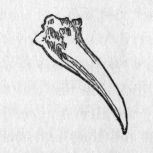
Thorn and his grandfather walked for a long time, but at last Flint pointed to a cave in the side of the hill and said, "We rest there."
As they came up, Thorn saw his grandmother sitting in the sun at her door. Flint said to her, "Here is Thorn, your grandson."
"The little man!" she said, and laid her rough hand on his shoulder gently.
Then she quickly cut off big pieces of the rhinoceros meat and ran a long stick through them, and placed the stick over the burning fire. While the meat was cooking, Flint was telling about Burr and her little family; and of Strongarm's surprise at the making of fire; and of the lion hunt; and of the sleeping tiger they had seen on the way home.
After the hungry man and boy had eaten great pieces of the roasted meat, they went to the stone yard. There Thorn heard the sound of stone hammers and saw a big rocky place in the hillside. Three men sat on the ground at work. Other men sat about talking. Pointing to these, Flint said, "They are waiting to buy axes."
There were piles of bowlders on the ground, and little piles of stone chips around each ax maker.
Flint went up to one of them and said, "Redtop, my boy wants to make axes. Show him how."
Redtop grinned at Thorn, and threw him a smooth oval bowlder.
"That is your hammer stone," he said. "Now take a stone about the size you want your ax, and chip it this way."
Redtop sat on the ground. He held a flint bowlder and began chipping it with his hammer stone. Every time he struck the bowlder, a chip flew off. He kept on striking, first on one side and then on the other. Thorn watched with shining eyes. Redtop worked fast and easily, and after some time held up a beautiful ax. It was broad at the sharp end and narrow at the head. Thorn saw the little places all over it where the chips had come off.
He looked at it and laughed, and then sat down and tried to do what Redtop had done. He struck with his hammer stone, but the bowlder did not chip. He worked on and on, for a very, very long time. Still the bowlder would not chip, and his arm was ready to drop off.
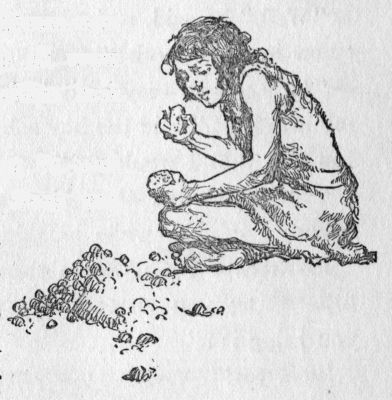
At last Redtop said, "Enough for to-day! You will do."
Thorn threw down his stones with a shout and ran to his grandfather.
Old Flint sat at work under a big beech tree. At his side there was a little pile of bowlders, and about him there were chips of flint.
"Well," he said, as he looked up at the boy, "how is stone work?"
"It is not so easy as it looks, and it makes my arm hurt," said the boy soberly; "but Redtop said that I would do."
"Um," grunted the old man with an unsmiling face, the while laughing to himself.
He worked on. After a time he said, "The little thing you shoot with, your bow—did you bring it?"
"Oh, yes!"
"Well, I will make a little stone head for the stick."
"Good, grandfather!" said Thorn, clapping his hands.
Flint took a pebble from the pile and struck it with his hammer stone. It did not chip in the right way, so he threw it on the chip pile. He struck another. That was too soft; he threw that away. He tried many pebbles before he found a good one.
"This will do," he said at last. "The chip leaves a slight rounding hollow like the inside of my hand."
Then he began to work. He held the pebble in his left hand and struck it a sharp blow with another pebble. He went on striking, round and round the pebble, taking off a flake or a big chip at every blow. At last the part of the pebble left was too small to work with any more. It was the core; he threw it away.
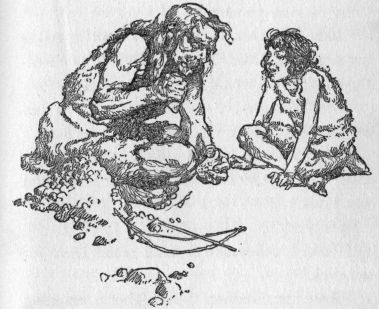
"We chip axes by striking," he then said to the young ax maker. "That way of chipping is good enough for axes; they are heavy and have, besides, the weight of the arm to carry the blow. With spear heads it is different; a spear is thrown, and the head should be sharp. I can get a smaller chip, and so a sharper edge, by pressing than by striking; so I chip my spear heads by pressure."
He laid a little piece of deer skin in his left hand. On this he laid one of the flakes he had just broken from the pebble, and held it fast with his fingers. Then he took a piece of deer antler.
"This antler," he said, "is soft enough to spring a little when I press it against the pebble. Yet it is hard enough to bring off a chip."
He began pressing with the antler along the edge of the flake. He pressed very hard; and every time he pressed, a little chip flew off. He worked very fast.
"I must not let a hump come in the middle," he said; "for then I should have a turtle back. Look on that chip pile; you will see many turtle backs that I have thrown away."
The old man was making the point now, and he began to sing:
"I give you the eye of the eagle,
To find the rabbit's heart!
I give you the eye of the eagle,
To find the rabbit's heart!"
As Thorn listened, and caught the meaning of the song, his eyes grew bright and he held his head high.
"Grandfather hopes that I will hunt with the little bow and spear!" he said to himself.
He was very glad. He began to dance and clap his hands in time with the old man's song. Then he caught the words and began to sing with his grandfather:
"I give you the eye of the eagle,
To find the rabbit's heart!
I give you the eye of the eagle,
To find the rabbit's heart!"
Before long the little spear head was done. It was thin and sharp and beautiful. Thorn tied it to the little straight stick, and he had an arrow for his bow!
Flint worked on.
"We make all of our axes and spear heads and knives and scrapers of flint," he said after a while. "It chips more easily than any other stone."
After some time Flint and the boy left the stone yard.
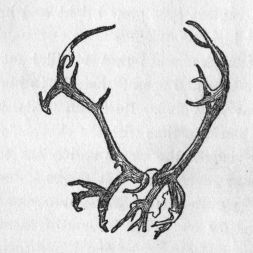
As they walked along, the old man pointed to a place in the hillside and said, "That is the gravel bed. From it we dig all the stone for our axes and spear heads."
Thorn looked and saw a big hollow in a gravel hill. The hill was made of sand and clay and pebbles and bowlders. The rain had washed some of the sand and clay away, and the stones had fallen down and now lay in piles on the ground.
"Men come from far away for our stone," the old man went on. "It is good stone for axes. They bring us shells and amber and meat and skins for our stone. Some of them take the stone to their homes and make their own axes; others buy our axes."
At the gravel bed, men were at work. One man had a big digging stick. He put it under a rock and pushed it out of the ground. Another man had the shoulder bone of a bear. He pushed it under some pebbles and lifted them and threw them upon an ox skin on the ground. Then he gathered up the corners of the skin, took it on his back, and carried it down to the stone yard.
As Thorn watched the men getting out stone for their axes and spear heads, he said to his grandfather, "Who made the axes for the cave men before you made them?"
"Oh, ever since the old days," said Flint, "there has been an ax maker. Some men can chip stone well and easily. Others can never learn to do it in their whole lives. So the men who can chip stone do it; and they are the ax makers. The other men use the axes, and they are the hunters.
"My grandfather told me," said Flint, as he walked slowly down the hill, "that in the old days the cave men did not have stone axes and spears. They hunted with sticks; they threw a stick like your mother's digging stick; and they struck with a stick like your father's hunting club. And they used the sharp stones they chipped only for knives and scrapers. But one day, a man thought about tying a sharp stone to a stick! There, you see, was the first spear!"
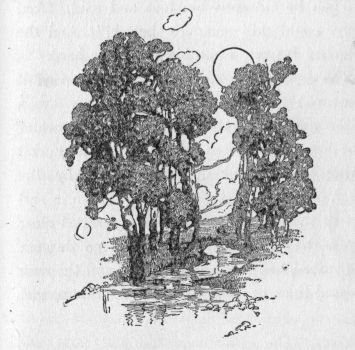
"That was a great day for the cave men!" Flint went on, while his grim face lighted up. "For with a stone weapon they could hunt the swift wild animals, and so get more food."
Then he stamped his foot and said, "And they could kill enemies better!" And he clenched his fist, while his face grew hard.
The next day, men from the stone yard went out to make a fish trap. They drove sticks across the river bed where the water was low. Then from stick to stick they tied string made of skin. Rushes grew by the river. They took these and wove them in and out of the strings until the trap reached clear across the river. The water could go through the rushes, but the fish could not; and the men speared them or caught them with their hands.

Berries were ripe now, and Flint and the other cave people around him left their caves and went to live near the berry fields. The men went out to hunt early next morning, and the women and children went to pick berries.
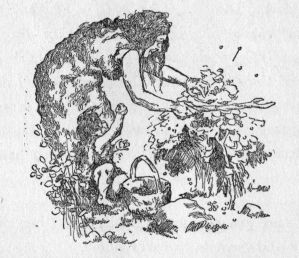
There were plenty of wild huckleberries and little yellow plums. The women and children ate and ate the sweet fruit, and then filled bags and baskets to carry home.
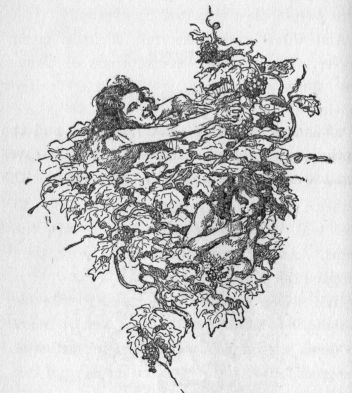
As they left the berry fields, the children pulled down the wild grape vines and bit into the little grapes. But they made faces and cried, "Oh, how sour! After awhile they will turn purple; then they will be sweeter."
And there were trees full of little green apples. The children tasted some of them, but threw them away. "Too sour!" they cried.
When day came to an end, the men gathered sticks and lighted the night fires. Then they threw themselves on skins, and all talked together. They called to each other from fire to fire, and told long stories till far into the night. At last, in the middle of a story, they dropped off to sleep.
Half asleep on his reindeer skin beside his grandfather, Thorn saw the old yellow moon go down. Around him he heard the noises of the great forest. Katydids and locusts and tree toads were singing, and from far away came the long howls of wolves. From a branch overhead a great snowy owl kept calling to his mate. That was the last the boy knew till the sun lighted up the tree tops.
The next evening it rained. The women quickly bent little trees over and tied their tops together and threw skins over them. Then they sat on the ground under the shelters and laughed and talked and watched the rain. Some of the women made baskets.
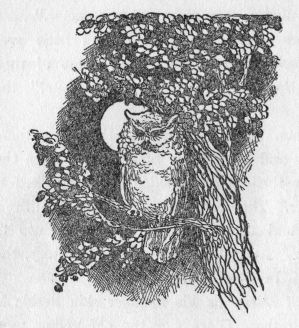
One woman had an elm branch. She broke off the rough outside bark to get the soft inside bark. This she pulled off in strips and twisted together into long strings. Then she broke little branches from the tree bending over her, and tied them together at one end. With two pieces of string, she wove under and over a stick and crossed the strings. In this way she wove around and around the basket to the top, and tied a stick for a handle.
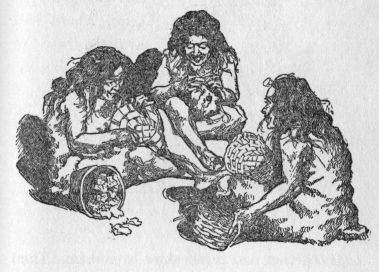
"I will place leaves in it, and then it will hold berries," she said.
One woman was making a bag of a bit of skin. She made holes near the edge of the skin and put a string through them and pulled them together. Another woman made a basket of birch bark in the same way.
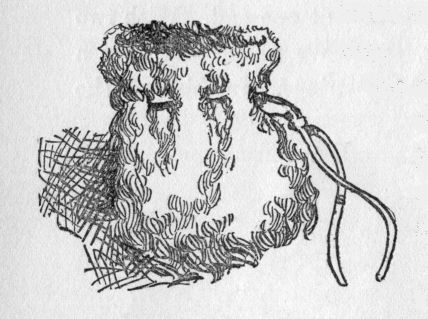
One day when the berries were about gone, Thorn saw a great herd of reindeer going by.
"Oh, look at all the reindeer, grandfather!" he cried. "Where are they going?"
"When summer comes," said Flint, "they go to a colder country; and when summer ends, they come back to the cave country."
There were many reindeer in the herd, and their antlers looked like a forest of trees without leaves. A big bear with hungry eyes was following the herd.
That evening a young hunter made a picture of a beautiful reindeer with his head among the grasses. Another hunter made a picture of two deer that he had killed, and two live deer. Still another man made a handle for a knife. He carved it from bone. It was like a deer springing. The antlers were laid back on the neck, and the front legs were turned under the body; the hind legs lay along the handle.
"Good!" said the other men as they looked at it.
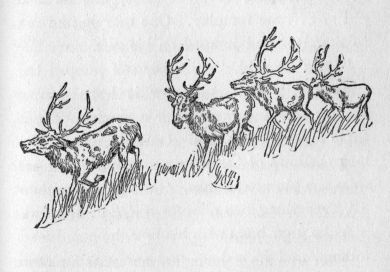
Every day Thorn worked for a little while at the chipping of stone axes, but he had plenty of time for play. One morning he ran to the river and jumped on his raft.
"Ha!" he said, "my other self jumped the stream with me. And now it leans over a shadow raft and reaches for a shadow pole."
He looked about him. On the grass lay the long shadows of the trees. In the clear water were the pictured banks.
"Everything has another self," he thought.
As he grew busy with his bow, he heard loud talking, and looked up and saw strange men and children coming along the other bank.
"The men are coming to buy axes," he thought. "The children have come along with them."
The men jumped into the river and swam across and went to the stone yard. But the children came swimming up around the raft like wild ducks. Some of them had long hair that floated about on the water.
"Are you Thorn, the cave boy?" one of them asked him.
"Yes, who are you?"
"I am Clam, a shell mound boy."
Then the children came up around the raft and shook it so that Thorn almost fell off.
"Stop, or I will shoot you!" he cried, laughing.
"Oh, he will shoot us!" cried the children, and they hid behind one another, playing they were afraid.
"Is that your bow?" Clam now asked. "We heard about it. Shoot for us."
"Yes," said Thorn.
He began to paddle to the bank, but the children crowded around the raft and quickly pushed it to shore. Thorn jumped off and began to shoot at the trees. The children went along with him and watched with big eyes. One of the arrows struck a tree and stuck in the bark. The children laughed and ran and pulled it out.
"Do that again!" they cried.
Thorn did it again to shouts and the clapping of hands. Then a boy named Periwinkle threw up a piece of bark and cried, "Hit that!"
Thorn tried over and over again, but he could not. At last he grew tired of shooting. Then the children crowded round him, and Clam said, "Come home with us. Show your bow to the other children."
"How can I get there?" Thorn asked.
"Swim across the river, then walk."
"I cannot swim."
The children laughed and thought that very strange, but Periwinkle said, "Well, we will push you on the raft."
"Yes, yes!" cried the other children.
So Thorn told his grandfather that he was going home with the shell mound people. And when the men had bought their axes, the children all ran down to the river together.
Some of the boys quickly tied a wild grape vine to the raft. Then they cried, "Here we go!" and dived into the river and swam away, pulling the raft. Laughing and shouting and splashing, the others jumped in and followed. They came up alongside the raft and pushed it with one hand and swam with the other.
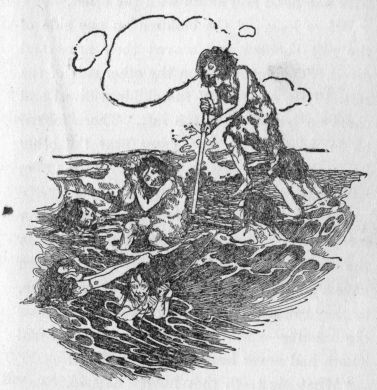
Before long, all the children on one side of the raft shouted and waved their arms and dived. They came up on the other side of the raft. Then the rest of the children dived and came up far ahead of the raft. Thorn looked on in wonder. As they came near the other bank, the girls pulled up the yellow water lilies and tied them in their wet hair.
The children walked along beside the river for a while. Hippopotamuses lay floating in the water, asleep in the sun. The children gave a great shout and woke up the river horses, as they called them. The animals opened their big mouths;—and the snorts, grunts, yawns! Thorn had never heard anything like it.
"What big teeth they have," he said.
"Yes, and just to eat grass," said another boy.
And soon some of the great rough things dived and came up with their mouths full of reeds.
A little farther along, Thorn saw beavers at work on the bank. They were carrying birch branches down to their homes beneath the little round mounds. And once in a while a water rat or snake swam across the river. Farther on, a flock of white swans floated. Their wings were raised a little, and their shadows floated with them.
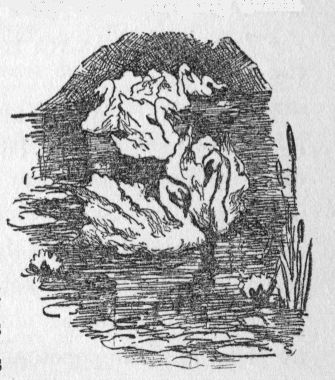
The children stopped to watch them.
"Pretty!" they said. "Swans and shadow swans!"
So laughing and playing and seeing strange and beautiful things, Thorn walked a long way with the children. At last, far off, he saw a long purple line.
"That is the sea," Periwinkle told him.
When they came to it, there was a big blue water with no shore on the other side. It was beautiful, and Thorn shouted as he saw the foam-capped waves roll in and break on the white sand.
Pointing to a place along the shore, the children said, "There is our home."
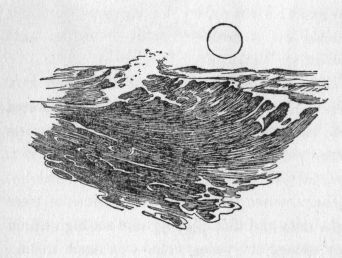
Dogs barked and ran up and down the shore among the people. The children ran along to their home. They were not afraid of the dogs, but petted them. And the dogs jumped about the children and played with them and were glad to see them.
The people of the shell mounds did not look just like the cave people. They were shorter and had rounder heads. But their eyebrows hung over their eyes, as the cave people's did. And they dressed in skins.
Their houses were made of branches of trees and stones and dirt. They were set high up on shore where the waves could not reach them.
Thorn walked about with the children and saw a great pile of shells. It lay far along the shore, and was higher than a man, and very wide.
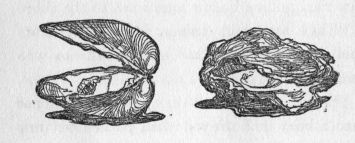
"What are you going to do with all these shells?" he asked Periwinkle.
"Do with them?" laughed Periwinkle. "Why, nothing. We threw them away. They show what good things we have had to eat, do they not, Foam?"
Foam was a girl with white teeth.
"Yes," said Foam, laughing. "They are shells of oysters and clams and periwinkles that we have eaten."
"Um-m! what lots of them you have eaten!" said Thorn, looking over the big pile.
"Yes," said Periwinkle, with a laugh, "we live on them."
"But you see," Foam went on, "our people have lived here for a long time—longer than my grandfather can remember. And the shell mounds have been growing all that time. There are many other shell heaps all along this shore, where more of our people live."
Thorn looked down to the water's edge and saw men pulling hollow logs down to the shore.
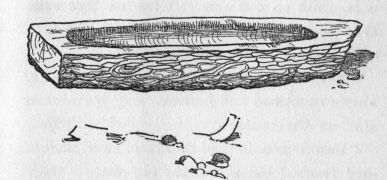
"They are going fishing in the dug-outs," said Periwinkle. "Come on, we will go with them."
The boys ran down to the shore and jumped into a boat that the men had pushed out into the water. Then the men also jumped in, and paddled out with sticks.
"Why do you call these dug-outs?" asked Thorn, rubbing his hand along the side of the boat.
"Because they are dug-outs," laughed Periwinkle. "You will see them made some day."
"Well, why do they not turn over?" Thorn asked next.
"Because they are flat on the bottom."
The dug-outs kept together and went a little way out to sea. One man had a bone spear. He saw a fish lying on the bottom and speared it.
"Oh, it is a flounder," said Periwinkle. "See, it is white on one side. It lies on that side. It is gray on the top side, and both the eyes are there."
Other men had long strings and bone hooks. They caught cod and herring.
When the boats were well filled with fish, the men began to paddle home. But before they reached the shore, the sky turned gray, and the sea grew rough, for the wind blew hard.
"This is nothing," said Periwinkle, laughing, as he saw the whites of Thorn's eyes. "You should see it sometimes. The waves are as high as a hill! Then we do not go fishing, and we live on foxes or rabbits or bears or ducks, or anything that we can kill. When we get nothing by hunting, we kill the dogs."
"Do the big waves ever turn the dug-outs over?" Thorn asked, with white lips.
"Yes, but we all swim."
When the boats reached shore, the women stood waiting. They were glad when they saw the fish, and quickly took them out. Then they began to cook them.
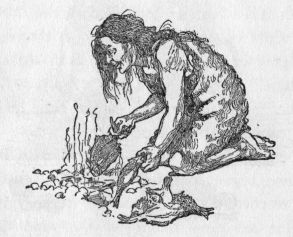
One woman laid her fish on hot coals to cook. Another put big leaves around hers and buried them in the ashes. One cooked hers in still another way. She went to a hole in the ground and lined it with a skin. She poured water into the hole and then put in hot stones until the water grew hot. Then she put in her fish.
When the fish were cooked, the women cut big pieces and gave them to their families. The people took the fish in their hands and sat down on the sand and ate.
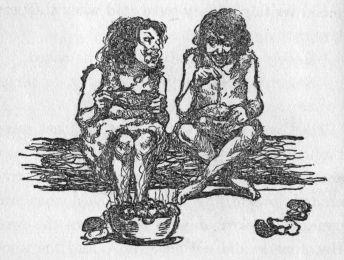
"Maybe you would like salt on your fish," said Foam to Thorn.
She took a little in her fingers and put it on his fish.
"That makes it taste better. Where do you get salt?"
"We burn sea-weed and get it."
When all the fish had been eaten, Periwinkle called, "They are going to hack down a tree. Come on, if you want to see it."
As the boys ran through the woods, Thorn saw nothing but fir trees.
"Have you no trees but firs?" he asked.
"No, only firs—firs, little and big, as far as you can see."
The boys followed the sounds that rang through the woods. Soon they saw men busy about a tree. One man was hacking a ring around it near the ground. When that was done, he hacked another ring above the first. His stone ax did not cut deep. And the wood between the two rings stayed there; it did not fly off in chips. So both men began to beat the wood between the rings with the flat side of their axes. Around and around the tree they went, and beat the chips to get them loose. Then, with a piece of antler, they worked under the chips until they came off. After that they hacked again in the rings, and again beat the wood between, and worked off the chips.
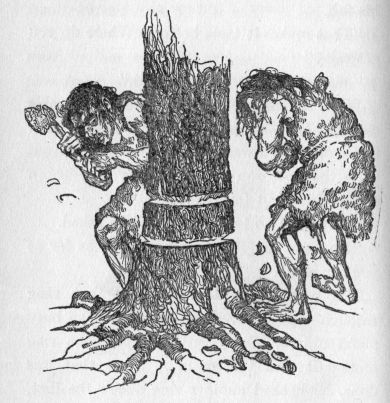
"Oh, come and play in the sand," at last cried Periwinkle. "They will be days hacking down that tree."
The boys ran back to the shore and lay down in the warm sand. They saw the purple sea, and the sea birds flying, and heard the waves breaking on the beach.
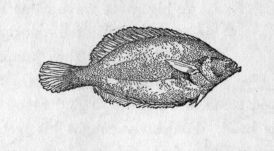
After a little the boys jumped up and ran into the water to play with the other children.
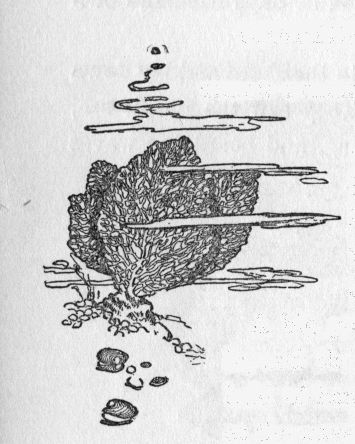
A big green wave came rolling in, and the children quickly took hold of hands. They jumped up as the wave broke over them. It knocked some of them down and stood Clam on his head. Somebody caught his feet, and the others all laughed. He came up angry and choking, when another wave caught him and rolled him over again. After that the boys came crowding around Thorn, waving their arms.
"You must learn to swim," they cried. "It is easy. Make your arms go this way and your feet this way"; and they showed him how.
Thorn tried it and went straight to the bottom. The boys shouted.
"Here is a log," they said. "Put your arms over that. It will keep you up till you learn."
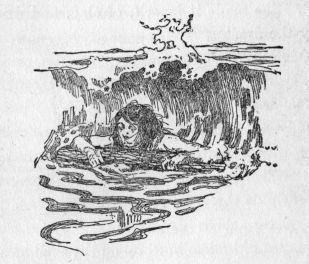
Thorn kept on trying, and in a few days he could swim a little.
"You do very well," said Foam.
The next day, when the tide was out, the boys waded in and picked up periwinkles and oysters and clams, and threw them up on the beach.
When Periwinkle began to open his oysters, he took a brown bowl to put them in. Once, in breaking a shell, his stone knife struck the bowl and broke it.
"Too bad," he said. "Mother liked that bowl. She made it herself, of clay, and dried it by the fire."
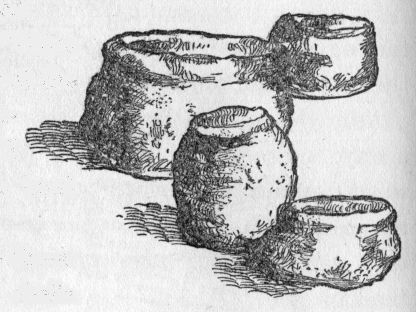
"Of clay!" Thorn said, looking at pieces wonderingly. "I never saw a bowl like that."
Periwinkle threw the oyster shells and pieces of broken bowl up on the shell heap. "We throw all such things in a heap," he said. "Then they are out of the way and will not cut our feet."
After working for days and days, the men got the tree for the dug-out hacked down. Then they hacked off a log and dragged it down to the shore. Here they began to make the dug-out.
They built a fire all along the top of the log. It burned down slowly. The men watched the fire and kept putting on more sticks. If it burned too near the edge, they put on water or clay or wet moss to stop it.
"You see, they burn out only the middle of the log and leave good strong thick sides to the boat," said Periwinkle.
After the fire had burned down into the log a way, the men raked off the hot coals. The wood beneath was burned to charcoal. The men scraped it off with stone scrapers. Then they put on more fire and again burned the log.
"The fire will burn down faster, now that the charcoal is scraped off," said Periwinkle.
The men worked for a long time, burning and scraping away, burning and scraping, until they had dug a little hollow all along the middle of the log.
Then one man said, "We have worked enough."
And the men dropped their scrapers and went off.
The next day Thorn walked along the beach and picked up pretty shells.
"These are for the folks at home," he said to Periwinkle. "They will put them on the strings around their necks."
"Here is my bow," he went on, handing it to Periwinkle. "You may keep it. I can make another. I am going back to my grandfather's now."
Periwinkle and Clam and some of the men went part way with Thorn. They walked for a long time through fir forests and then came to the forests of oak and beech and ash and chestnut. Here Thorn left his friends, and waved his arm to them as he ran on to his grandfather's. The shell people went back to their home by the sea.
One morning after Thorn had come back to his grandfather's cave, he woke up with tears on his face.
"Last night when I was asleep," he said to himself, "my shadow self went away to the home cave. And there it saw my mother and Pineknot and the baby sitting about the fire, just as they used to sit. And they were talking about me, saying that they wanted to see me. And I want to go home to see them."
The homesick boy went into the woods for comfort; he loved to watch the wild things going about. Not far off, he saw a herd of mammoths feeding. He never tired of looking at the big hairy elephants with their turned-up tusks and long snaky trunks. They were reaching up for the tender leaves of the birch, or needles of the hemlock, and would carry the green stuff to their mouths with their trunks. Young ones with shaggy coats of woolly hair, were playing about their mothers or eating grass. Sometimes one of the big mothers would give her young one a bunch of leaves. Then she would rub it gently with her trunk, petting it.
The herd ate on toward the edge of the woods. Then, following a big mammoth, it left the forest and went toward a swamp.
Thorn slipped down from his tree and ran to another one on the edge of the woods, where he could get a better view. From here he saw the mammoths out in the swamp. Some were drinking, others were wallowing, and still others were throwing water over themselves with their trunks. After getting a thick coat of mud on their shaggy skins, the herd began to leave the swamp.
But one big mammoth did not leave with the others. He could not; he had gone far out in the swamp. His feet sank in the soft mud; and when he tried to pull them out, he found them stuck fast. Then he began to trumpet. At this the whole herd grew uneasy and turned back and walked round him, waving their trunks and trumpeting and throwing mud and water.
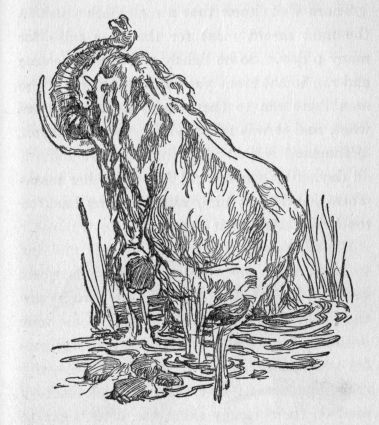
Thorn well knew that a mammoth stuck in the mud meant meat for the cave folks for many a day. So he lightly slid down the tree and ran to the stone yard with the news. The men there ran to the nearest caves with the word, and it was sent on from cave to cave.
The herd stayed with the mired mammoth all day. But when night fell, the other mammoths slowly left him, often turning back to touch him with their trunks and to trumpet.
A crowd of cave men had already gathered, and were waiting in the woods until the herd should leave. They now made fires around the mammoth to keep off the wolves and hyenas that had already begun to skulk about. And then they killed the mammoth with their spears.
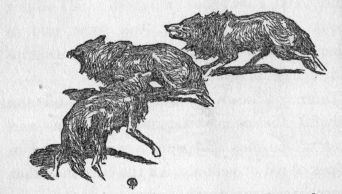
As the sun rose next morning, Thorn and his grandfather and grandmother went over to the swamp. The cave people soon began to come in from all the caves round about in the hill country. They came in little crowds, laughing and talking very loud. They were happy, for there was plenty to eat and somebody to eat with. As they came up, they stood for a long time looking at the mammoth and talking about how big he was. And some told of other mammoths that had got stuck in swamps and of how they had found them.
Thorn sat down on the side of a hill and watched the people coming. The arms and faces of the men and women were painted in stripes of red or yellow. All the cave men that Thorn knew were there, and many that he did not know. Before long his own family came.
Soon after that the men began to cut great pieces of meat from the mammoth. They gave them to the women to roast. The women made fires and put stones in them to get hot. They dug holes in the ground and rolled into them some of the hot stones. Next they threw meat upon the hot stones and rolled more hot stones upon it. Then they covered the holes with dirt and built fires upon them. While the meat was roasting, the women went over to watch the men playing.
The men were talking together in a crowd. A man named Crowfoot stood out and shouted, "I can climb a tree faster than any man here!"
"No, no!" shouted five or six men who jumped up and ran to trees.
"Go!" called a man.
They all jumped as high as they could and then climbed very fast, hand over hand, feet and legs pushing as if a wounded bear were after them. Crowfoot reached the top first.
Everybody shouted, "Crowfoot! Crowfoot!"
Then a man with big arms stood out and said, "I am best man in throwing the spear!"
A dozen men snatched spears and ran out. Everybody stood where he could see. The men with spears stood far back from a tree. One threw. His spear struck the tree, but fell. Everybody laughed. The next man threw.
His spear missed the tree. Everybody yelled and roared. Strongarm threw. His spear struck and stood in the tree shaking.
"Strongarm!" shouted the people.
Other men threw, whose spears stood in the tree. Then those men ran and pulled out their spears and stood farther back and threw again. Each man threw many times. Strongarm's spear stood oftenest in the tree from the longest distance.
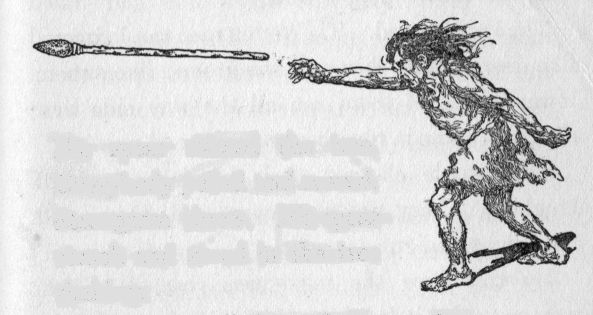
"Strongarm's eye is best!" the others shouted. "His arm is strongest!"
After that a young man cried, "I have flying feet! Who will run with me?"
"I will!"
"I will!"
And young men ran out and stood beside him, and all the people watched.
The race started. The young men ran lightly, like deer. They skimmed the ground like swallows. Some of them ran all the way side by side, and came in together sweating and panting.
The people clapped their hands and said laughing, "They are good cave men; they can both fight and run away."
By this time the meat was roasted. The women pulled it from the holes with long sticks, and the people took great pieces in their hands and ate them, and then took more.
"Mammoth meat is good and juicy," one man said.
"Yes," said another, "but not so tender as horse or reindeer meat."
After eating all they wanted, Thorn and Pineknot and old Hickory's children and some of the other children went off to play. They played being grown up; and Thorn fought with the other little hunters and caught and carried off a wife, and played living with her and their children in a cave.
The men ate for a long time, but at last they had enough. Then they began to break up the tusks of the mammoth, and they gave a piece to each man who had helped to kill the animal.
"To wear on your necklace," they said.
And they gave a piece to Thorn because he had found the mired mammoth. Strongarm looked at him proudly then, and the boy stood straight and tall and held his head high.
A man standing near him snatched for the piece of tusk, but Strongarm shouted, "Get off!" and scowled and shook his fist.
The man grew angry and raised his stone ax. Strongarm snatched his, and in a minute there was a clash of stone axes. The other men stood around and watched. They loved a good fight. Before long Strongarm's ax crashed down on the man's head, and he fell over and lay still. The others looked at him, and then went on breaking up the tusks.
After that every man grew busy, and began to cut as much meat from the big bones of the mammoth as he could carry. One bone was all cut bare. Three men standing near it whispered together. Then they lifted the bone and carried it toward a man who could not make axes and was too lazy to hunt. They set it down before him.
"This is your prize," they said, without a smile.
Everybody was looking.
The man turned red and snatched a spear. But the other men ran away and laughed. And everybody laughed.
Then the people started homeward, carrying the mammoth meat. Thorn said good-bye to his grandfather for a while and went home with his mother. Old Hickory and his family went along with Strongarm and his family, and the children ran through the bushes and scared up the wild rabbits and porcupines.
When they reached the cave, Thorn told Pineknot all over again about the mammoth. And he scratched a picture on the piece of tusk to show him. Holding up the picture he said, "This is the way the angry mammoth looked. His mouth was open, and his trunk was up. When still a long way off, the men heard him trumpeting."
Then Thorn made another picture of the mammoth. In it he showed the big body with the long hair, and the turned-up tusks, the long trunk, the small eyes, and the shaggy ears.
Thorn was very happy that evening, as he sat in his old place by the fire. Pineknot sat beside him, and Wow wow lay at his feet.
Last summer a little boy went to visit his grandfather who lived near one of the beautiful lakes in the northern part of our own land. The family doctor was very kind to the boy and often took him on long walks into the country.
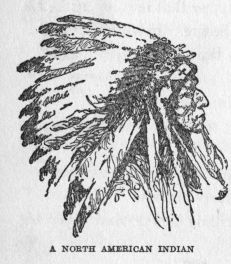
One day, as they were going through the woods together, the boy said to his friend, "Grandpa says that when he first came here, red men lived all about him, and that they made their houses of skins and called them wigwams. Afterwards the red men were all moved to the west and given land there. But grandpa says that for years after they went away, he used to find their arrow heads and stone axes as he turned up the ground in plowing. I wish that I could find an arrow head!"
As the doctor walked on he pointed to a pebble half buried in the sand beside the path. The boy stooped; there was a beautiful arrow head! He was very glad. Seeing that he was pleased, the doctor took him to his office and showed him hundreds of arrow heads. Some of them were small and finely chipped.
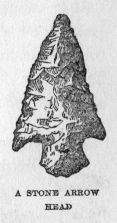
"These are bird arrows," the doctor said.
Then he showed large arrows.
"These are for killing buffalo and other big game."
And there were stone axes and hammers. Lastly, the doctor showed him something that looked like a little, very old hatchet. The boy turned it over and over and looked at it. It was all weather stained, and reddish-brown and green.

"This is not stone," the boy said at last.
"No," said the doctor, "that is a copper hatchet. I was very glad to get that because there are not many of them found now. You know that when Columbus came to our country, red men lived all over the land. They were in what we call the Stone Age; that is, they made their tools and weapons of stone. But there are great lumps of copper beside one of our lakes here. Now copper, you know, is a rather soft metal, and the red men about here learned to pound it into shape for weapons. They called both their stone hatchets and copper hatchets 'tomahawks.'
"Red men never learned to melt iron and make tools of it as we do, though there was plenty of iron in the mountains among which many tribes lived. The red men never got beyond the Stone Age and into the Iron Age as white men did."
"Where did you get all these beautiful stone things?" the boy asked after a while, looking at them with longing eyes.
"I have been years in getting them together," the doctor said. "Many of them I found myself, on my walks through the country. Others I bought from the people who found them."
"You must love them very much," said the boy.
"I do," said his friend, "and some day I shall give them all to a museum where they will be kept for people to see."
If you should cross the broad ocean that lies toward the rising sun, you would come to a beautiful country called France. Here grow the olive, the orange, and the grape; and the mulberry, on which the silk worm feeds. But it is not with these that we have to do to-day, but with some strange old things that once lay buried far below the soil in which they grow.
About seventy years ago, a man in that country who sold sand and gravel found that his own gravel pits were worked out. He went to the banks of a river—the river Somme—near by and found a good gravel bed, which he began to cut down and cart off to sell. He dug away at the hill for months and got far below the top of the ground. Then one day his spade struck something hard; he dug it out and saw that it was a very large bone.
"That is a queer bone," he said to himself. "I wonder what animal it belonged to. It is too big to have been the bone of a horse or a cow. It is big enough to have belonged to an elephant. Well, no matter what it came from," he said, throwing it aside, "it is neither sand nor gravel, so it is nothing to me."
As he dug on, he threw out some rudely shaped stones.
"These are queer, too," he said, "but they will not sell for gravel." And away went the stones from his shovel.
That evening a learned man from Paris, the most beautiful city of France, was walking beside the river and looking at the sunset clouds in sky and water.
There in the pit lay the big bones. He saw them. Forgotten were clouds and sky! He knew that he was looking at the bones of some animal long since gone from the earth! For years after that, he watched the work in the gravel pits and carried away any bones and shaped stones that were dug out. He studied them and found that some of the bones were those of the mammoth, and that there were bones of the rhinoceros too.
At last he showed the bones and the stones to the learned men in Paris, and said, "These stones are very old; they are as old as the ground in which they lay. They were shaped by men who knew very little and had very little, and who used them for weapons. Near the stone weapons were these bones of the mammoth and the rhinoceros. So those animals lived at the time the men did, and in this country."
The learned men listened, but did not believe what he said.
A few years after that, however,—about twenty years,—other shaped stones were found on the banks of the river that flows by the great city of London, in England, across the narrow water from France. And in Denmark, another country near France, still more shaped stones were found, and, with them, bones of the reindeer.
Then the learned men had to believe that men who shaped stones once lived in England and France and Denmark; and that at the same time lived the mammoth, the rhinoceros, and the reindeer; and that the men had very little and knew very little, and made the shaped stones for weapons.
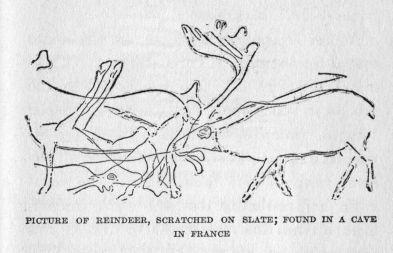
Soon after this, chipped stones were found all the world over. More than that, there were people living who still were chipping them. The Eskimo, who live in the frozen north of our own country, make their weapons of stone.
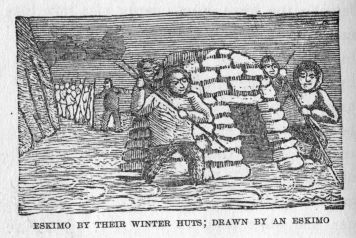
So you see that by the Age of Stone is meant a time when the metals—tin and copper and iron—were not known; and when stone, horn, bone, shell, and wood were used for tools and weapons. The cave men were in the Stone Age long ago. The Eskimo are in the Stone Age now. And the American red men, though they were still in the Stone Age, were beginning to learn the use of one metal—copper.
And the people of the shell mounds—how do we know about them? In Denmark to-day you may see shell mounds. They are the old hunting and fishing villages. They are of different sizes; some are a quarter of a mile long and half as wide. They are built up of things that the hunters and fishermen threw away: oyster and mussel and periwinkle shells; bones of the wolf, the hyena, the dog; of wild duck, swan, and grouse; of cod, herring, flounder, and other deep-sea fish. Many of the bones had been split open for the purpose of extracting the marrow. Besides bones, there are also pieces of burnt wood; and there is sea plant, which may have given salt.

The stone tools and weapons found in the heaps are axes, knives, hammers, awls, lance heads, and sling stones—all of rude make. There are also bits of rude pottery, which show that these men knew a little more than the cave men; they knew how to bake clay. They were ahead of the cave men also in having one tamed animal—the dog. No bones were found of any tamed animal except the dog, and this seems to show that it was the earliest animal tamed by man.
Mounds like those in Denmark are found in many other countries: in our own land where the red men lived; in Africa, the land of the black man; and in Asia, where the brown man lives. Wherever man has led a wandering life, eating fish and leaving their bones behind him, these heaps are found; and they are always by the sea or by a river.
At the time when the cave men and the shell men lived, the earth looked much as it looks now, as far as hills and rivers and trees and grass could make it. The earth had its seasons—its spring and summer, its autumn and winter. Then, as now, the forests dropped their leaves in autumn. Many leaves of oak, maple, poplar, and hickory fell upon clayey soil and left their imprints; and the clay afterwards turned to stone, and the imprints show us that the forests of the cave men were like our own.
The insects, too, were the same as those of our own fields. We know this because the gum flowed down the pine trees then as now; and ants, crickets, butterflies, grasshoppers, and spiders visiting the tree were held and covered. The gum turned to stone and made the amber of a later time and kept the insects within it unchanged, and there within the amber we see the insects that the cave men knew.
The animals, also, were much the same as those of our own time. It seems strange to us that at that time the reindeer and the mammoth should have lived in the same country; because the reindeer of our time lives in a cold country, and the elephant, which is like the mammoth, lives in a hot country. But before the time of the cave men, it was warm in England and France, and the mammoth went to live there then. Afterwards, it became colder; but the mammoth liked it there, so he grew himself a coat of thick woolly hair to keep out the cold and stayed, while the reindeer lived there only in winter and went northward in summer.
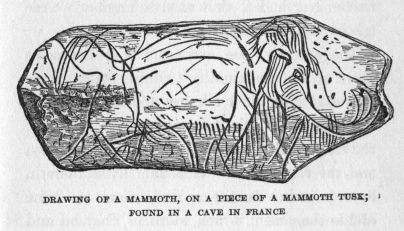
We know that the mammoth had this heavy coat of wool because, in the cold country of Siberia, some time since, there was a mammoth thawed out of the ice; and also because the cave men have left a drawing that pictures the long hair. It was about a hundred years ago, when a fisherman on the frozen Lena River saw an iceberg of odd shape. Two years later, he saw the tusks of a mammoth standing out from it. And five years after that, all the ice had melted from around it, and the big body of the mammoth lay upon the sand. There was a flowing mane on the neck, and the body was covered with reddish wool and long black hair. The people about the country there cut up the flesh as food for their dogs, and the bones and tusks were sent to the museum in St. Petersburg.
Thousands of teeth and tusks of mammoths have been brought up by the nets of fishermen in the North Sea, that washes England. And whole islands along that coast are made up of nothing but ice and sand and the teeth and tusks of mammoths. During every storm, pieces of this old ivory are washed loose and cast ashore; and the fishermen sell them.
It is thought that what is now the North Sea was, at the time the elephants lived there, a swamp in which the animals went to drink and bathe, and in which, at times, they became mired; and that this is why so many of their bones are found along that coast.
Mammoths were very like big elephants, with tusks that turned up. There are none on earth now. Neither are there any cave tigers. And the two-horned rhinoceros has gone, and the great snowy owl.
Caverns and rock shelters in which men of the Stone Age lived have been found in many places in our own country and in other lands. But caves are few, even in limestone countries; and these early, stone-chipping men lived the world over. So, in the open places and in forests among wild beasts, they must have dug pits for safety or made rude huts of earth or branches.
In caverns there have been more bones of horse and reindeer found than of any other animals; and this shows that the early hunters did best in killing these animals. There have been few bones of mammoths found; but that is because those bones were mostly too heavy for the cave people to carry away. It is likely that the flesh was eaten on the spot where the animal was killed.
All early peoples made their songs by singing over and over a line or two. And into these words they put what they were thinking most about, or hoping for. They believed that the whispered wish went into the thing they sang to, and helped to bring about the thing they hoped for. So the old axmaker, in time to his chipping, sings over and over to the arrow head:
"I give you the eye of the eagle,
To find the rabbit's heart.
I give you the eye of the eagle,
To find the rabbit's heart."
And the mother sings to the child:
"Though a baby,
Soon a-hunting after berries
Will be going."
Early men believed that since they themselves are alive and move, all other things that move also are alive, and have feelings and likes and dislikes as men have. The rustling leaves, the waving grass, a rolling stone, a drifting cloud, the rising moon—all are to them alive, and many of them are to be feared.
The speech of the cave and the shell men was made up of few words, and the meaning was helped out by motions of the hands and body. They knew little outside of their forest life, and probably could not count beyond three. But the power to grow was in them, and from such rude beginnings came the men who built the cities of Paris and London.
Up to a short time ago, on the island of Tasmania, near Australia, there lived a people more nearly like the cave men than any people we know about. Their weapons were made of limestone and were without handles, because they did not know how to fix handles to them. Their boat was a raft of bark bundles and was pushed by a pole. They lived under shelters made of boughs, and made fire by twirling a stick on a piece of soft wood. They drew rude pictures on bark; and they were quick and cunning about hunting, but knew little more. They believed that the shadow of a thing was its other self—the self that traveled in dreams and that lived after the body died; and that the echo was the talking shadow. Like the cave men these people were hunters, without any tamed animal to help them.
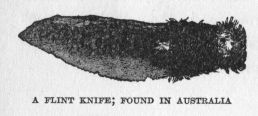
The teacher who wishes to make the most of this work will take her class to visit a museum, if a museum is available; or, if not, she will do what she can to show her class actual specimens of the things described in the story.
In a museum primitive implements should be observed, and specimens of animals and birds. Pictures of caves, pieces of stalactites, stalagmites, of limestone, quartz, and flint would be of value, either seen in the museum or, better still, looked at and handled in the classroom as the story is read. A tendon procured from the butcher and dried for a few weeks and then pulled to pieces would show primitive thread.
Out of doors a limestone cliff showing stratification would be the best kind of illustration to explain both the formation of caves and the gradual burying and preservation of animal bones and other primitive relics.
In the schoolroom, again, on a large stand might be made a model of a hilly country. A cave could be shown, shaped of two upright stones and a crosspiece, the whole covered with sods and earth; and animals and men might be made of paper or of clay.
Various scenes from the story are adapted to dramatization; for instance, the visit of the cave bear, the making of fire, work in the stone yard, or the feast of mammoth's meat.
For those who wish to read further in a subject so suggestive along the lines, not only of social life, but of history, geography, and nature study, the following books will be full of interest:
The Story of Primitive Man. Clodd. D. Appleton & Company, 50 cents. (If only one book on the subject is purchased, this is the most valuable for the price.)
Early Man in Britain. Dawkins.
Cave Hunting. Dawkins.
Ancient Stone Implements. Evans.
Primitive Man. Figuier.
The Origin of Inventions. Mason.
Woman's Share in Primitive Culture. Mason.
Some First Steps in Primitive Culture. Starr.
Myths and Dreams. Clodd.
Primitive Culture. Tylor.
Prehistoric Times. Lubbock.
Animals of the Past. Lucas.
The Beginnings of Art. Grosse.
Prehistoric Europe. Geikie.
Materiaux. Massenet.
Phases of Animal Life, Past and Present. Lyddecker.
Royal Natural History. Lyddecker.
Ancient Quarry Sites. Holmes.
The Language of Paleolithic Man. Brinton.
Ancient Society. Morgan.
The Descent of Man. Darwin.
The Voyage of the Vega. Nordenskj÷ld.
The History of America, Vol. I. Payne.
The Story of Ab. Waterloo.
THE AUTHOR
End of the Project Gutenberg EBook of The Cave Boy of the Age of Stone, by
Margaret A. McIntyre
*** END OF THIS PROJECT GUTENBERG EBOOK THE CAVE BOY OF THE AGE OF STONE ***
***** This file should be named 18576-h.htm or 18576-h.zip *****
This and all associated files of various formats will be found in:
http://www.gutenberg.org/1/8/5/7/18576/
Produced by Al Haines
Updated editions will replace the previous one--the old editions
will be renamed.
Creating the works from public domain print editions means that no
one owns a United States copyright in these works, so the Foundation
(and you!) can copy and distribute it in the United States without
permission and without paying copyright royalties. Special rules,
set forth in the General Terms of Use part of this license, apply to
copying and distributing Project Gutenberg-tm electronic works to
protect the PROJECT GUTENBERG-tm concept and trademark. Project
Gutenberg is a registered trademark, and may not be used if you
charge for the eBooks, unless you receive specific permission. If you
do not charge anything for copies of this eBook, complying with the
rules is very easy. You may use this eBook for nearly any purpose
such as creation of derivative works, reports, performances and
research. They may be modified and printed and given away--you may do
practically ANYTHING with public domain eBooks. Redistribution is
subject to the trademark license, especially commercial
redistribution.
*** START: FULL LICENSE ***
THE FULL PROJECT GUTENBERG LICENSE
PLEASE READ THIS BEFORE YOU DISTRIBUTE OR USE THIS WORK
To protect the Project Gutenberg-tm mission of promoting the free
distribution of electronic works, by using or distributing this work
(or any other work associated in any way with the phrase "Project
Gutenberg"), you agree to comply with all the terms of the Full Project
Gutenberg-tm License (available with this file or online at
http://gutenberg.org/license).
Section 1. General Terms of Use and Redistributing Project Gutenberg-tm
electronic works
1.A. By reading or using any part of this Project Gutenberg-tm
electronic work, you indicate that you have read, understand, agree to
and accept all the terms of this license and intellectual property
(trademark/copyright) agreement. If you do not agree to abide by all
the terms of this agreement, you must cease using and return or destroy
all copies of Project Gutenberg-tm electronic works in your possession.
If you paid a fee for obtaining a copy of or access to a Project
Gutenberg-tm electronic work and you do not agree to be bound by the
terms of this agreement, you may obtain a refund from the person or
entity to whom you paid the fee as set forth in paragraph 1.E.8.
1.B. "Project Gutenberg" is a registered trademark. It may only be
used on or associated in any way with an electronic work by people who
agree to be bound by the terms of this agreement. There are a few
things that you can do with most Project Gutenberg-tm electronic works
even without complying with the full terms of this agreement. See
paragraph 1.C below. There are a lot of things you can do with Project
Gutenberg-tm electronic works if you follow the terms of this agreement
and help preserve free future access to Project Gutenberg-tm electronic
works. See paragraph 1.E below.
1.C. The Project Gutenberg Literary Archive Foundation ("the Foundation"
or PGLAF), owns a compilation copyright in the collection of Project
Gutenberg-tm electronic works. Nearly all the individual works in the
collection are in the public domain in the United States. If an
individual work is in the public domain in the United States and you are
located in the United States, we do not claim a right to prevent you from
copying, distributing, performing, displaying or creating derivative
works based on the work as long as all references to Project Gutenberg
are removed. Of course, we hope that you will support the Project
Gutenberg-tm mission of promoting free access to electronic works by
freely sharing Project Gutenberg-tm works in compliance with the terms of
this agreement for keeping the Project Gutenberg-tm name associated with
the work. You can easily comply with the terms of this agreement by
keeping this work in the same format with its attached full Project
Gutenberg-tm License when you share it without charge with others.
1.D. The copyright laws of the place where you are located also govern
what you can do with this work. Copyright laws in most countries are in
a constant state of change. If you are outside the United States, check
the laws of your country in addition to the terms of this agreement
before downloading, copying, displaying, performing, distributing or
creating derivative works based on this work or any other Project
Gutenberg-tm work. The Foundation makes no representations concerning
the copyright status of any work in any country outside the United
States.
1.E. Unless you have removed all references to Project Gutenberg:
1.E.1. The following sentence, with active links to, or other immediate
access to, the full Project Gutenberg-tm License must appear prominently
whenever any copy of a Project Gutenberg-tm work (any work on which the
phrase "Project Gutenberg" appears, or with which the phrase "Project
Gutenberg" is associated) is accessed, displayed, performed, viewed,
copied or distributed:
This eBook is for the use of anyone anywhere at no cost and with
almost no restrictions whatsoever. You may copy it, give it away or
re-use it under the terms of the Project Gutenberg License included
with this eBook or online at www.gutenberg.org
1.E.2. If an individual Project Gutenberg-tm electronic work is derived
from the public domain (does not contain a notice indicating that it is
posted with permission of the copyright holder), the work can be copied
and distributed to anyone in the United States without paying any fees
or charges. If you are redistributing or providing access to a work
with the phrase "Project Gutenberg" associated with or appearing on the
work, you must comply either with the requirements of paragraphs 1.E.1
through 1.E.7 or obtain permission for the use of the work and the
Project Gutenberg-tm trademark as set forth in paragraphs 1.E.8 or
1.E.9.
1.E.3. If an individual Project Gutenberg-tm electronic work is posted
with the permission of the copyright holder, your use and distribution
must comply with both paragraphs 1.E.1 through 1.E.7 and any additional
terms imposed by the copyright holder. Additional terms will be linked
to the Project Gutenberg-tm License for all works posted with the
permission of the copyright holder found at the beginning of this work.
1.E.4. Do not unlink or detach or remove the full Project Gutenberg-tm
License terms from this work, or any files containing a part of this
work or any other work associated with Project Gutenberg-tm.
1.E.5. Do not copy, display, perform, distribute or redistribute this
electronic work, or any part of this electronic work, without
prominently displaying the sentence set forth in paragraph 1.E.1 with
active links or immediate access to the full terms of the Project
Gutenberg-tm License.
1.E.6. You may convert to and distribute this work in any binary,
compressed, marked up, nonproprietary or proprietary form, including any
word processing or hypertext form. However, if you provide access to or
distribute copies of a Project Gutenberg-tm work in a format other than
"Plain Vanilla ASCII" or other format used in the official version
posted on the official Project Gutenberg-tm web site (www.gutenberg.org),
you must, at no additional cost, fee or expense to the user, provide a
copy, a means of exporting a copy, or a means of obtaining a copy upon
request, of the work in its original "Plain Vanilla ASCII" or other
form. Any alternate format must include the full Project Gutenberg-tm
License as specified in paragraph 1.E.1.
1.E.7. Do not charge a fee for access to, viewing, displaying,
performing, copying or distributing any Project Gutenberg-tm works
unless you comply with paragraph 1.E.8 or 1.E.9.
1.E.8. You may charge a reasonable fee for copies of or providing
access to or distributing Project Gutenberg-tm electronic works provided
that
- You pay a royalty fee of 20% of the gross profits you derive from
the use of Project Gutenberg-tm works calculated using the method
you already use to calculate your applicable taxes. The fee is
owed to the owner of the Project Gutenberg-tm trademark, but he
has agreed to donate royalties under this paragraph to the
Project Gutenberg Literary Archive Foundation. Royalty payments
must be paid within 60 days following each date on which you
prepare (or are legally required to prepare) your periodic tax
returns. Royalty payments should be clearly marked as such and
sent to the Project Gutenberg Literary Archive Foundation at the
address specified in Section 4, "Information about donations to
the Project Gutenberg Literary Archive Foundation."
- You provide a full refund of any money paid by a user who notifies
you in writing (or by e-mail) within 30 days of receipt that s/he
does not agree to the terms of the full Project Gutenberg-tm
License. You must require such a user to return or
destroy all copies of the works possessed in a physical medium
and discontinue all use of and all access to other copies of
Project Gutenberg-tm works.
- You provide, in accordance with paragraph 1.F.3, a full refund of any
money paid for a work or a replacement copy, if a defect in the
electronic work is discovered and reported to you within 90 days
of receipt of the work.
- You comply with all other terms of this agreement for free
distribution of Project Gutenberg-tm works.
1.E.9. If you wish to charge a fee or distribute a Project Gutenberg-tm
electronic work or group of works on different terms than are set
forth in this agreement, you must obtain permission in writing from
both the Project Gutenberg Literary Archive Foundation and Michael
Hart, the owner of the Project Gutenberg-tm trademark. Contact the
Foundation as set forth in Section 3 below.
1.F.
1.F.1. Project Gutenberg volunteers and employees expend considerable
effort to identify, do copyright research on, transcribe and proofread
public domain works in creating the Project Gutenberg-tm
collection. Despite these efforts, Project Gutenberg-tm electronic
works, and the medium on which they may be stored, may contain
"Defects," such as, but not limited to, incomplete, inaccurate or
corrupt data, transcription errors, a copyright or other intellectual
property infringement, a defective or damaged disk or other medium, a
computer virus, or computer codes that damage or cannot be read by
your equipment.
1.F.2. LIMITED WARRANTY, DISCLAIMER OF DAMAGES - Except for the "Right
of Replacement or Refund" described in paragraph 1.F.3, the Project
Gutenberg Literary Archive Foundation, the owner of the Project
Gutenberg-tm trademark, and any other party distributing a Project
Gutenberg-tm electronic work under this agreement, disclaim all
liability to you for damages, costs and expenses, including legal
fees. YOU AGREE THAT YOU HAVE NO REMEDIES FOR NEGLIGENCE, STRICT
LIABILITY, BREACH OF WARRANTY OR BREACH OF CONTRACT EXCEPT THOSE
PROVIDED IN PARAGRAPH F3. YOU AGREE THAT THE FOUNDATION, THE
TRADEMARK OWNER, AND ANY DISTRIBUTOR UNDER THIS AGREEMENT WILL NOT BE
LIABLE TO YOU FOR ACTUAL, DIRECT, INDIRECT, CONSEQUENTIAL, PUNITIVE OR
INCIDENTAL DAMAGES EVEN IF YOU GIVE NOTICE OF THE POSSIBILITY OF SUCH
DAMAGE.
1.F.3. LIMITED RIGHT OF REPLACEMENT OR REFUND - If you discover a
defect in this electronic work within 90 days of receiving it, you can
receive a refund of the money (if any) you paid for it by sending a
written explanation to the person you received the work from. If you
received the work on a physical medium, you must return the medium with
your written explanation. The person or entity that provided you with
the defective work may elect to provide a replacement copy in lieu of a
refund. If you received the work electronically, the person or entity
providing it to you may choose to give you a second opportunity to
receive the work electronically in lieu of a refund. If the second copy
is also defective, you may demand a refund in writing without further
opportunities to fix the problem.
1.F.4. Except for the limited right of replacement or refund set forth
in paragraph 1.F.3, this work is provided to you 'AS-IS', WITH NO OTHER
WARRANTIES OF ANY KIND, EXPRESS OR IMPLIED, INCLUDING BUT NOT LIMITED TO
WARRANTIES OF MERCHANTIBILITY OR FITNESS FOR ANY PURPOSE.
1.F.5. Some states do not allow disclaimers of certain implied
warranties or the exclusion or limitation of certain types of damages.
If any disclaimer or limitation set forth in this agreement violates the
law of the state applicable to this agreement, the agreement shall be
interpreted to make the maximum disclaimer or limitation permitted by
the applicable state law. The invalidity or unenforceability of any
provision of this agreement shall not void the remaining provisions.
1.F.6. INDEMNITY - You agree to indemnify and hold the Foundation, the
trademark owner, any agent or employee of the Foundation, anyone
providing copies of Project Gutenberg-tm electronic works in accordance
with this agreement, and any volunteers associated with the production,
promotion and distribution of Project Gutenberg-tm electronic works,
harmless from all liability, costs and expenses, including legal fees,
that arise directly or indirectly from any of the following which you do
or cause to occur: (a) distribution of this or any Project Gutenberg-tm
work, (b) alteration, modification, or additions or deletions to any
Project Gutenberg-tm work, and (c) any Defect you cause.
Section 2. Information about the Mission of Project Gutenberg-tm
Project Gutenberg-tm is synonymous with the free distribution of
electronic works in formats readable by the widest variety of computers
including obsolete, old, middle-aged and new computers. It exists
because of the efforts of hundreds of volunteers and donations from
people in all walks of life.
Volunteers and financial support to provide volunteers with the
assistance they need, is critical to reaching Project Gutenberg-tm's
goals and ensuring that the Project Gutenberg-tm collection will
remain freely available for generations to come. In 2001, the Project
Gutenberg Literary Archive Foundation was created to provide a secure
and permanent future for Project Gutenberg-tm and future generations.
To learn more about the Project Gutenberg Literary Archive Foundation
and how your efforts and donations can help, see Sections 3 and 4
and the Foundation web page at http://www.pglaf.org.
Section 3. Information about the Project Gutenberg Literary Archive
Foundation
The Project Gutenberg Literary Archive Foundation is a non profit
501(c)(3) educational corporation organized under the laws of the
state of Mississippi and granted tax exempt status by the Internal
Revenue Service. The Foundation's EIN or federal tax identification
number is 64-6221541. Its 501(c)(3) letter is posted at
http://pglaf.org/fundraising. Contributions to the Project Gutenberg
Literary Archive Foundation are tax deductible to the full extent
permitted by U.S. federal laws and your state's laws.
The Foundation's principal office is located at 4557 Melan Dr. S.
Fairbanks, AK, 99712., but its volunteers and employees are scattered
throughout numerous locations. Its business office is located at
809 North 1500 West, Salt Lake City, UT 84116, (801) 596-1887, email
business@pglaf.org. Email contact links and up to date contact
information can be found at the Foundation's web site and official
page at http://pglaf.org
For additional contact information:
Dr. Gregory B. Newby
Chief Executive and Director
gbnewby@pglaf.org
Section 4. Information about Donations to the Project Gutenberg
Literary Archive Foundation
Project Gutenberg-tm depends upon and cannot survive without wide
spread public support and donations to carry out its mission of
increasing the number of public domain and licensed works that can be
freely distributed in machine readable form accessible by the widest
array of equipment including outdated equipment. Many small donations
($1 to $5,000) are particularly important to maintaining tax exempt
status with the IRS.
The Foundation is committed to complying with the laws regulating
charities and charitable donations in all 50 states of the United
States. Compliance requirements are not uniform and it takes a
considerable effort, much paperwork and many fees to meet and keep up
with these requirements. We do not solicit donations in locations
where we have not received written confirmation of compliance. To
SEND DONATIONS or determine the status of compliance for any
particular state visit http://pglaf.org
While we cannot and do not solicit contributions from states where we
have not met the solicitation requirements, we know of no prohibition
against accepting unsolicited donations from donors in such states who
approach us with offers to donate.
International donations are gratefully accepted, but we cannot make
any statements concerning tax treatment of donations received from
outside the United States. U.S. laws alone swamp our small staff.
Please check the Project Gutenberg Web pages for current donation
methods and addresses. Donations are accepted in a number of other
ways including checks, online payments and credit card
donations. To donate, please visit: http://pglaf.org/donate
Section 5. General Information About Project Gutenberg-tm electronic
works.
Professor Michael S. Hart is the originator of the Project Gutenberg-tm
concept of a library of electronic works that could be freely shared
with anyone. For thirty years, he produced and distributed Project
Gutenberg-tm eBooks with only a loose network of volunteer support.
Project Gutenberg-tm eBooks are often created from several printed
editions, all of which are confirmed as Public Domain in the U.S.
unless a copyright notice is included. Thus, we do not necessarily
keep eBooks in compliance with any particular paper edition.
Most people start at our Web site which has the main PG search facility:
http://www.gutenberg.org
This Web site includes information about Project Gutenberg-tm,
including how to make donations to the Project Gutenberg Literary
Archive Foundation, how to help produce our new eBooks, and how to
subscribe to our email newsletter to hear about new eBooks.
*** END: FULL LICENSE ***